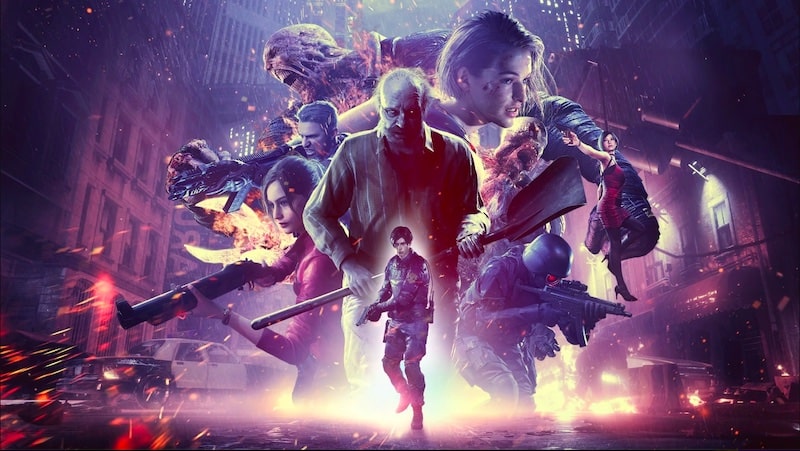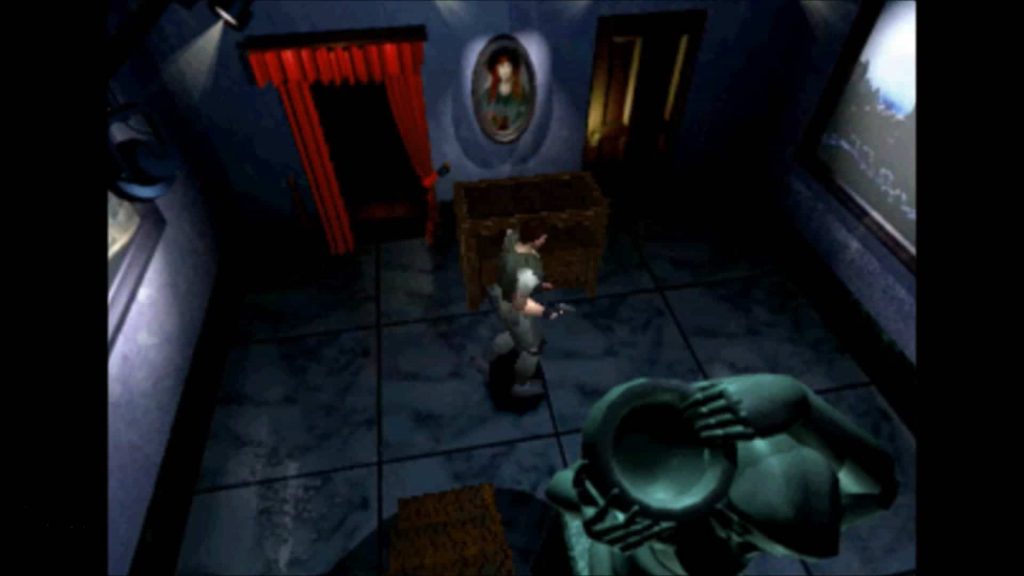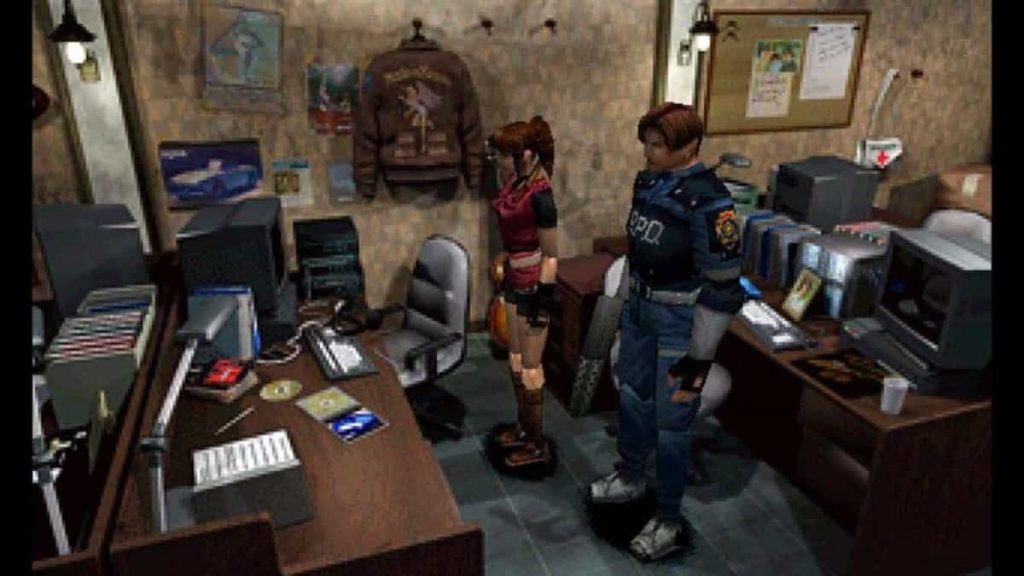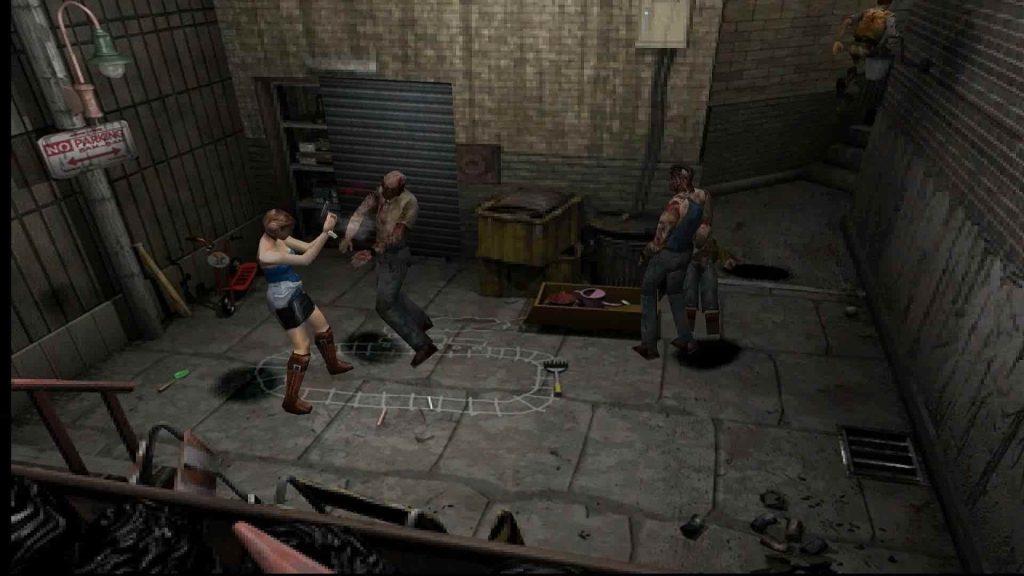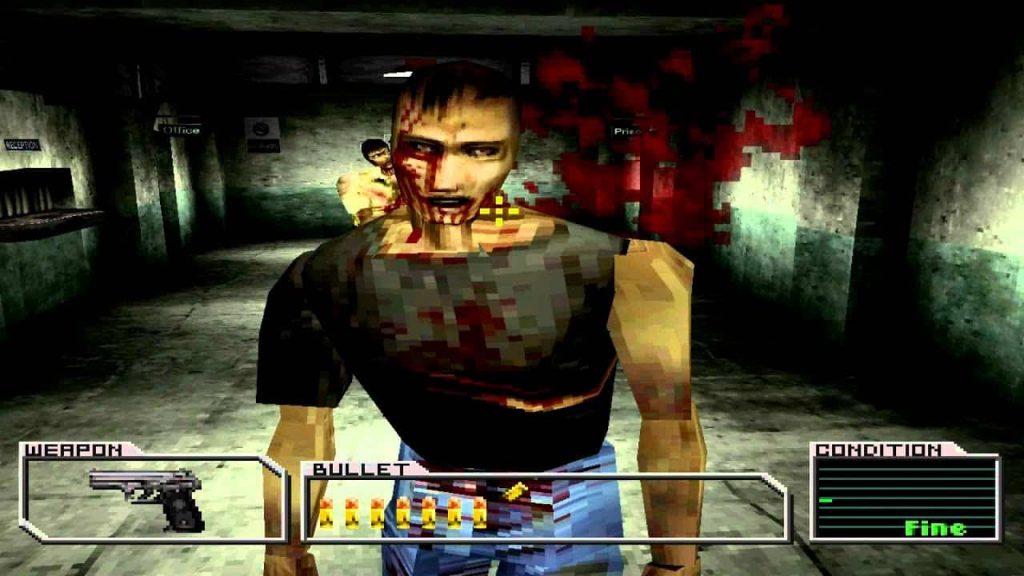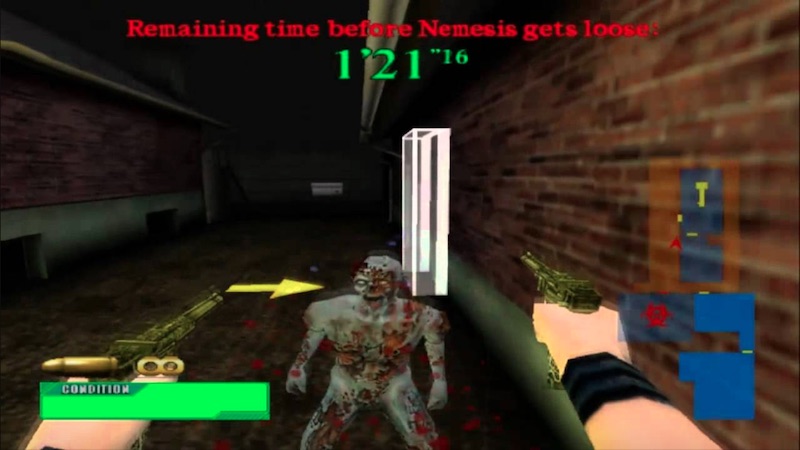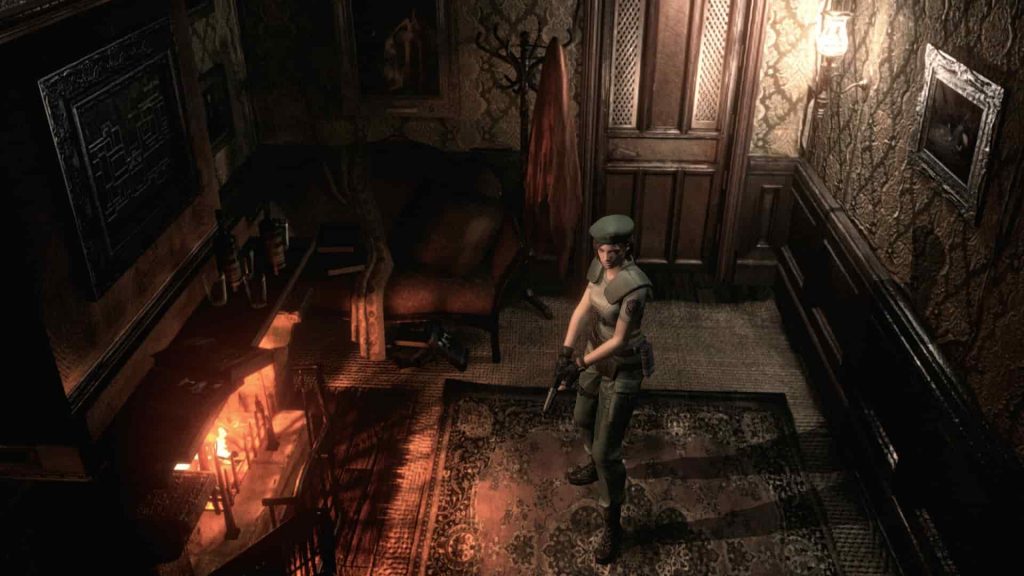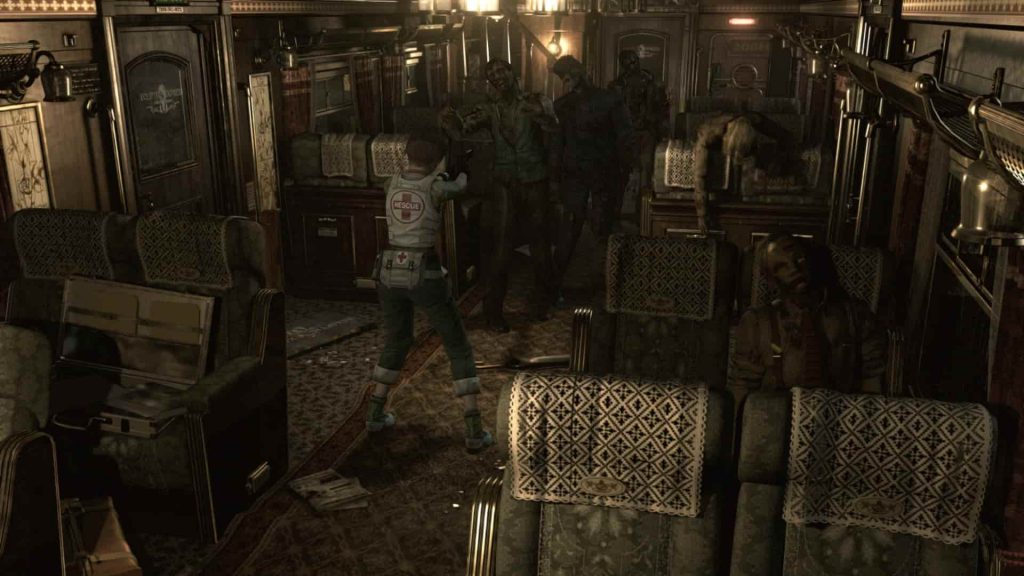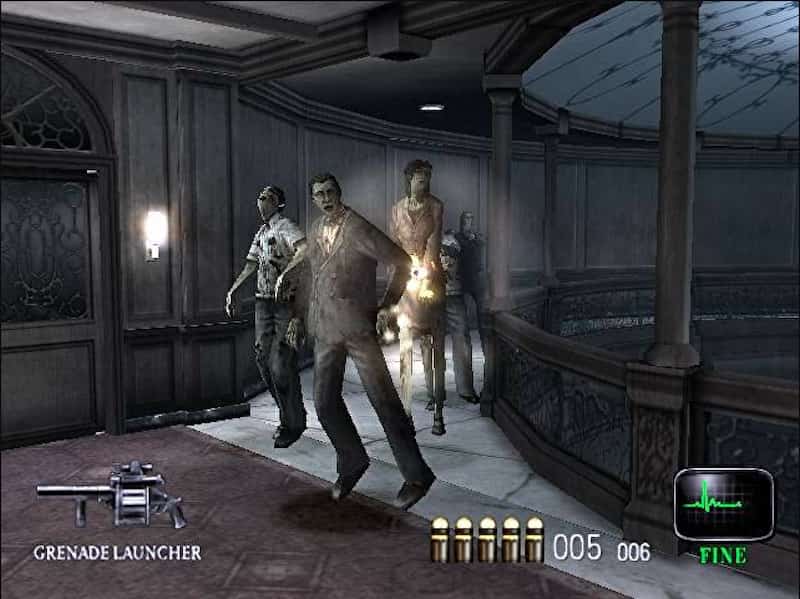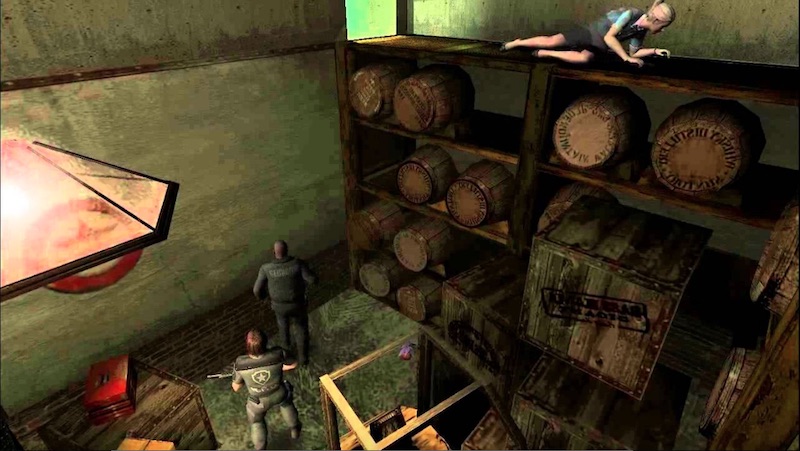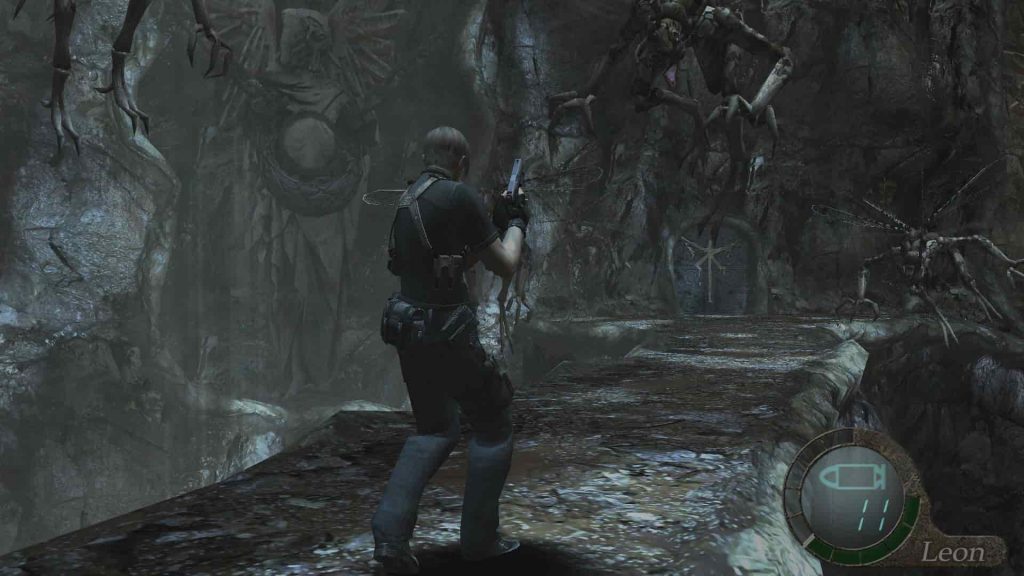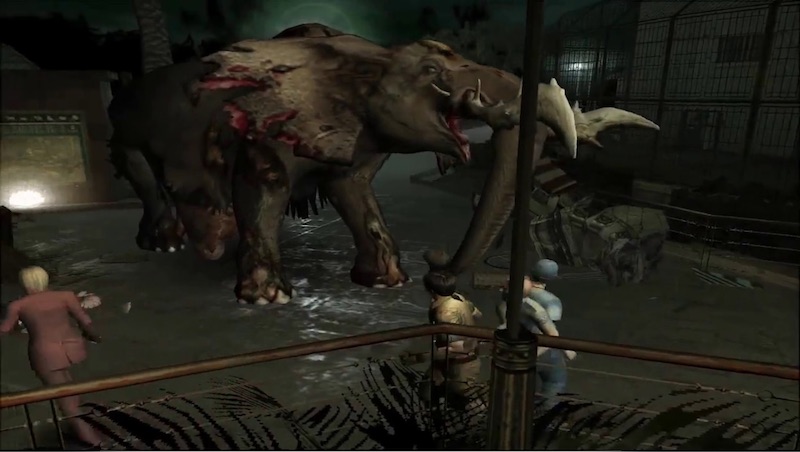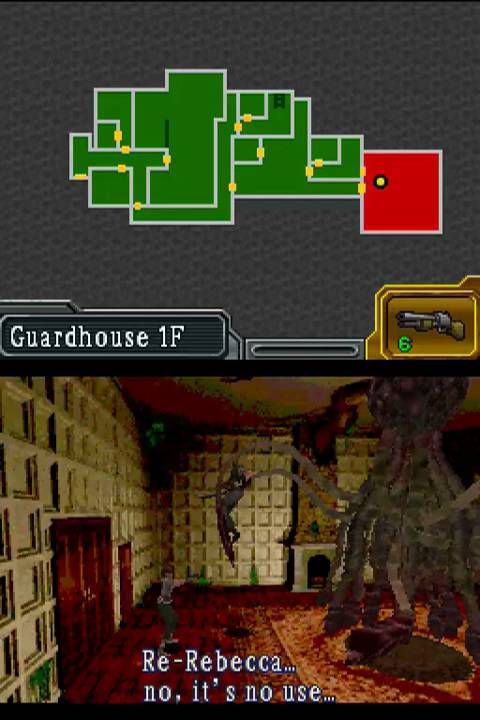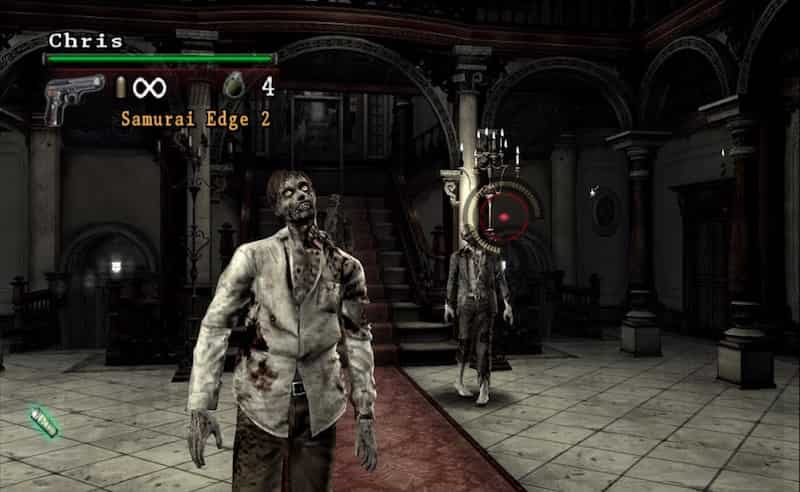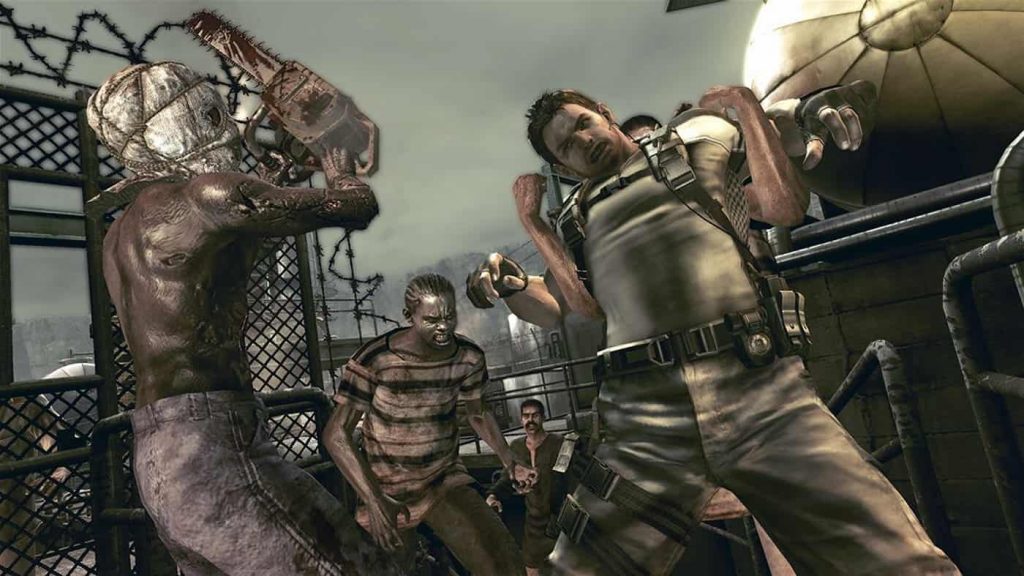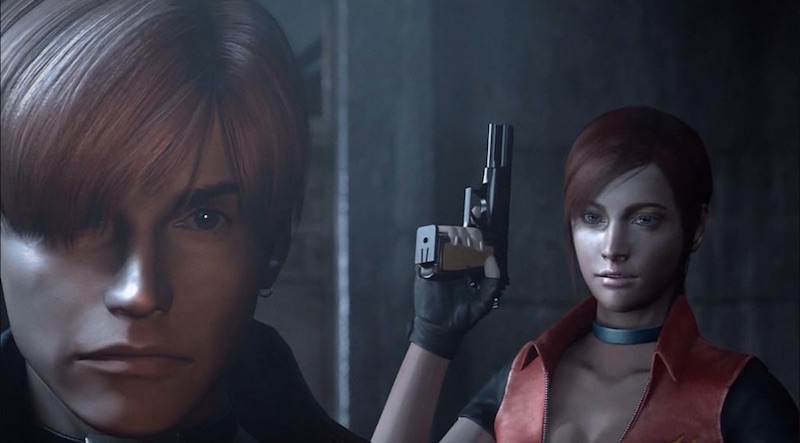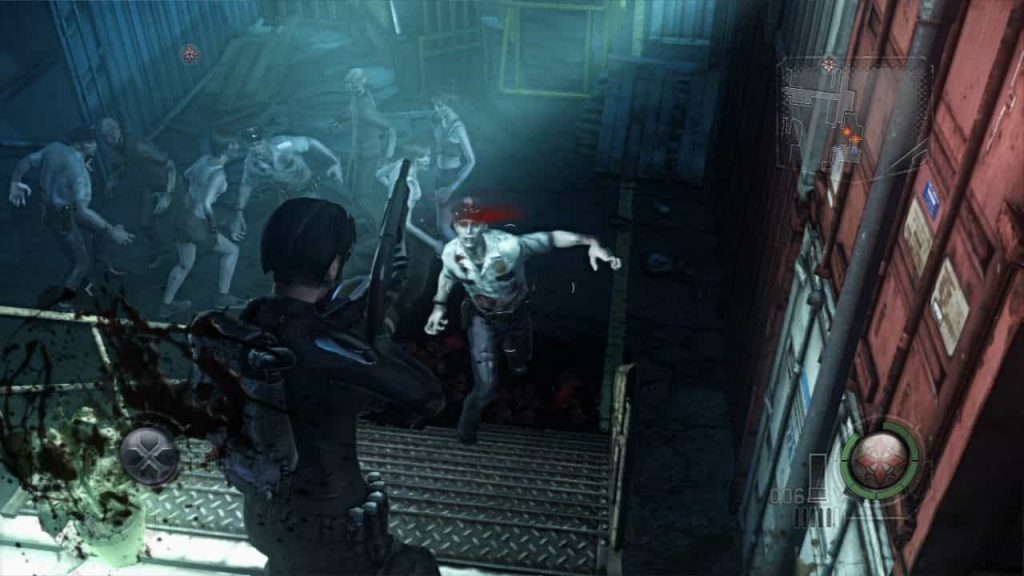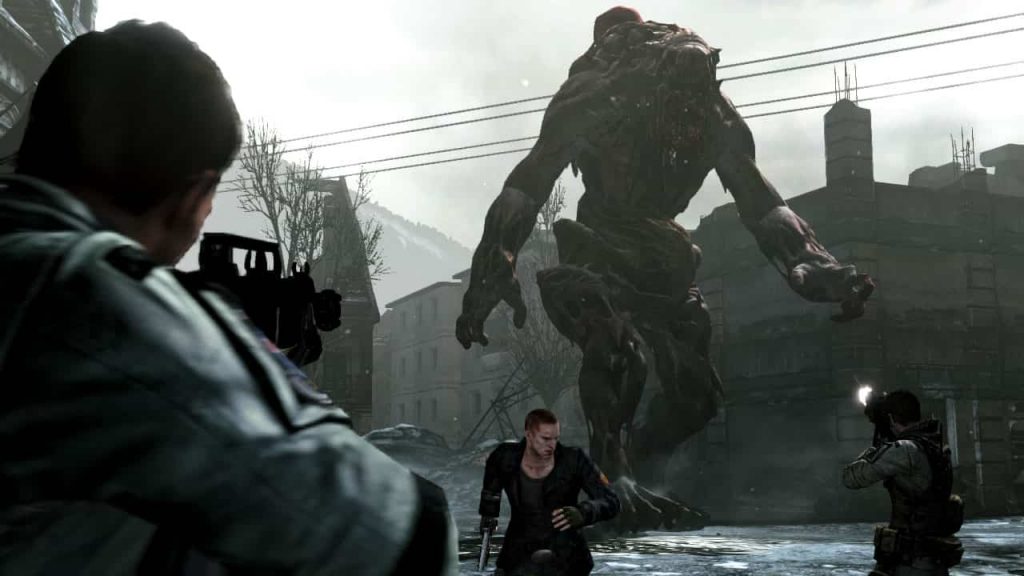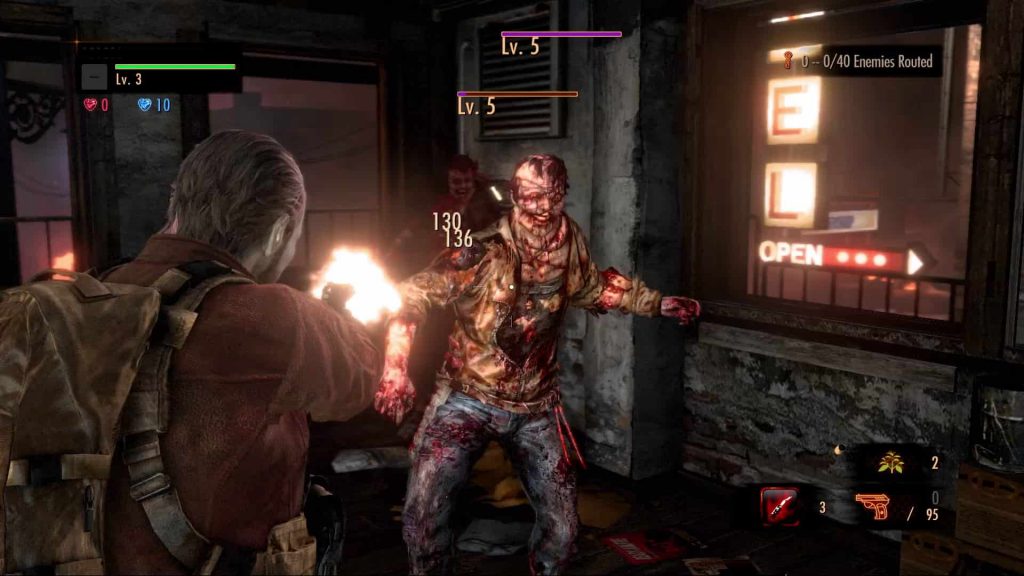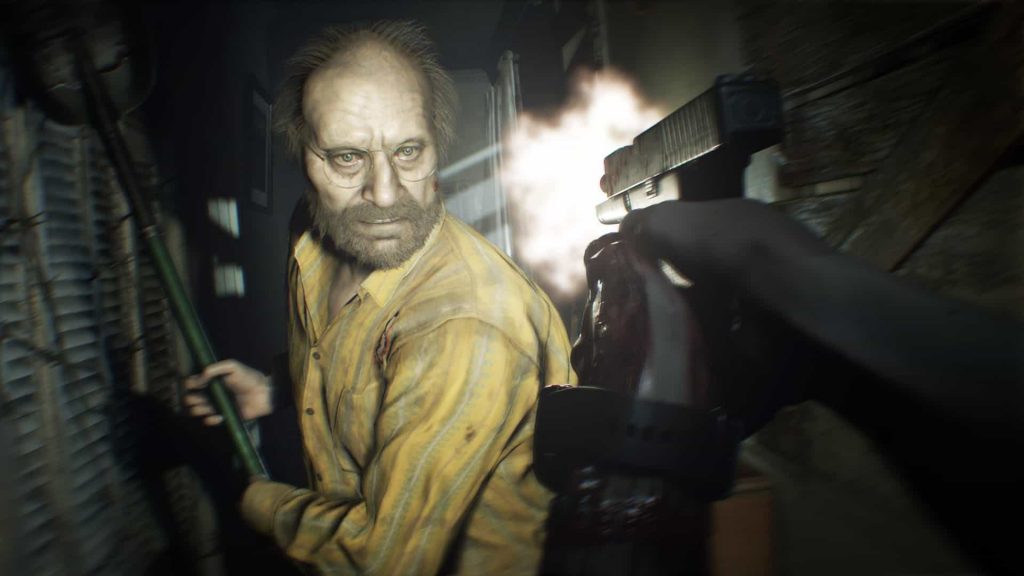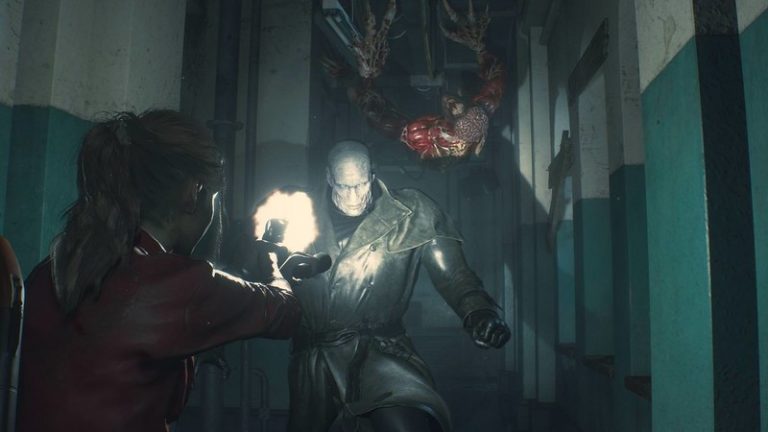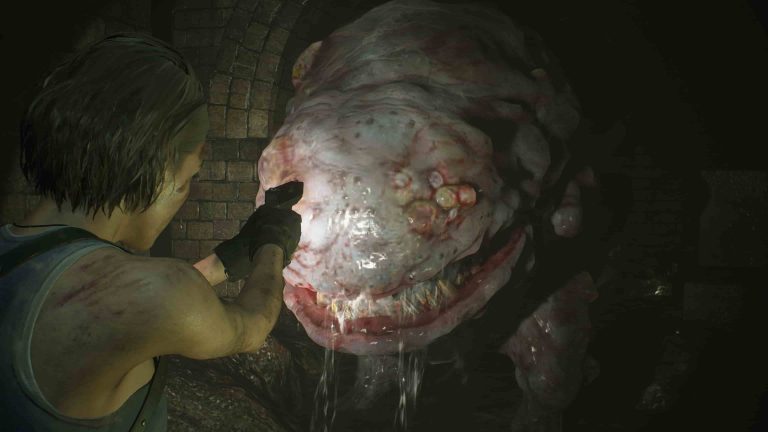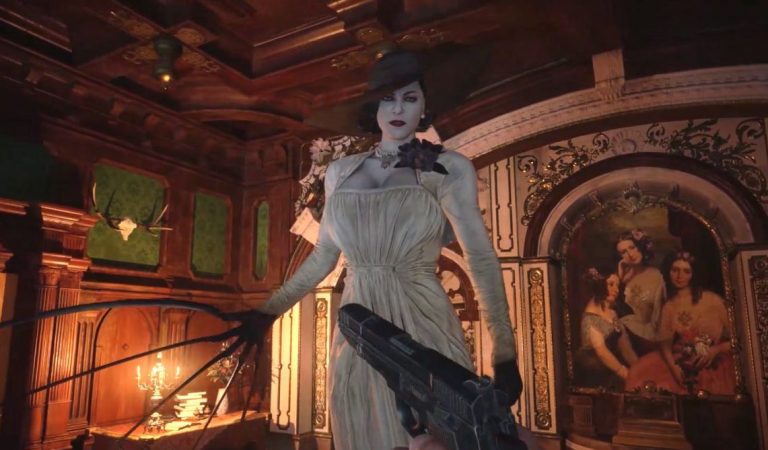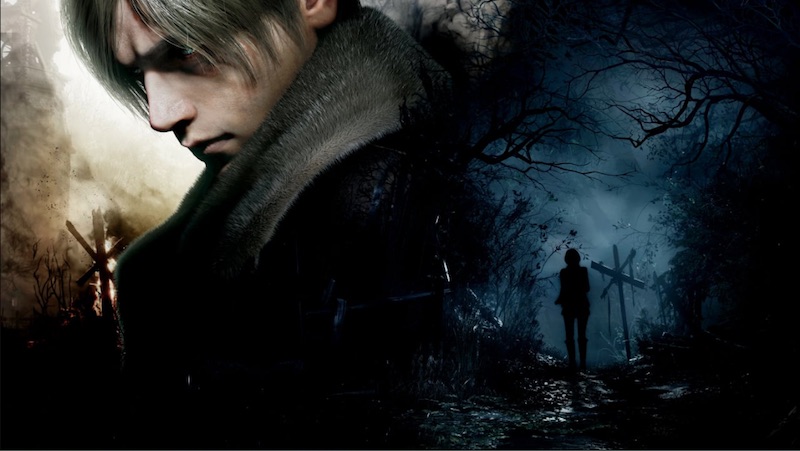With the launch of the Resident Evil Village now in our rear view mirror, and to celebrate the incredible history of the Resident Evil series, we’re going to take you on a journey. It starts right at the very beginning in 1996 when were first started our adventure at the Spencer Estate, right up until the present day with Resident Evil 4 Remake.
The History Of Resident Evil
Long before zombies became the ubiquitous, go-to horror monster in video games and TV series, we had Resident Evil. And back then, the were scary. One of the most influential video game franchises on the market, Resident Evil’s impact on the industry cannot be understated; even today, you see countless titles inspired by Capcom’s brain-splattering series, from indie darlings to triple-A endeavours. Resident Evil is as synonymous with zombie video games as Call of Duty is with first-person shooters, and isn’t afraid to reinvent itself, even if it doesn’t always work out.
Owning much of its inspiration to legendary film maker George A. Romero, along with early video game horror entries Sweet Home and Alone in the Dark (the latter of which coined the term ‘ambient survival horror’) Resident Evil offered a critical turning point for the ailing brand, propelling the now infamous Survival Horror genre onto the mainstream consciousness.
With 28 years and over 135 million sales under its belt, PSU presents our updated History of Resident Evil article compiled by yours truly, a fan of the series since 1997. Yes, I’m old! Here you’ll find a comprehensive list of all mainline games and key spin-offs, which may hopefully reveal some interesting details you didn’t know about the series, as well as some interview snippets from gaming magazines from the 90s via my personal collection.
Grab a first-aid spray and shotgun, and read on!
Resident Evil (a.k.a. Biohazard)
Release Date: March 22, 1996 (Japan), March 30, 1996 (North America), August 1, 1996 (Europe)
Platform: Sony PlayStation (Sega Saturn and PC ports also release)
Global Sales: 5,331,647 (including all ports)
Here’s where it all started. Directed by Shinji Mikami (who up until that point had worked on Disney games like Goof Troop), Resident Evil made its Japanese debut under the name of Biohazard on March 22, 1996 exclusively for Sony’s PlayStation console. Originally conceived as a First Person Shooter, the game’s concept endured several transitions throughout its lengthy development cycle, with early designs toying with the idea of a two-player cooperative mode via link cable. Scrapped characters included Dewey and Gelzar, a comic relief figure and hulking augmented solider, respectively, who were eventually replaced by Rebecca and Barry.
Said Mikami-san on the game’s two-player origins:
I thought about it for the first Resident Evil, but we gave up – technically it wasn’t good enough.
Set in the fictional mid-western town of Raccoon City on July 24, 1998, Resident Evil kicks off following the insertion of the S.T.A.R.S. (Special Tactics and Rescue Service) Alpha Team in nearby mountainous region of Raccoon Forest, who have been dispatched to locate and rescue the missing Bravo Team. The Bravos had been instructed to conduct a search of the area earlier in the day for missing hikers following an onslaught of several cannibalistic homicides in the region over the past few months.
Alpha Team (featuring Albert Wesker, Chris Redfield, Jill Valentine, Barry Burton, Brad Vickers and Joseph Frost) spot the smoking ruins of their colleagues’ chopper and land to investigate. There, they find it abandoned, although Joseph stumbles across a severed hand still holding a gun before promptly getting his throat ripped out by a pack of zombified dobermans. Things get worse for the Alphas as Brad abandons them in the woods, forcing the team to flee into the nearby mansion. And that’s where you begin your adventure, after a wonderfully 90s cast introduction that shows Wesker styling his hair and Barry fumbling with his magnum.
For me, Resident Evil is the quintessential Survival Horror experience; a gripping marriage of suspense, exploration, classic B-movie scare tactics, and a healthy sprinkle of puzzle solving for good measure. Packed with two distinct campaigns as Chris or Jill, Resident Evil sees you exploring the mansion, courtyard, underground, guard house, and more while getting to the bottom of various conundrums peppered across the sprawling estate while fending off the various genetically-engineered horrors infesting the grand abode.
The game employs the now-infamous tank control scheme and you have to hold a button down to run, while door opening and stair-climbing segments are ostensibly use to build tension but are really a mask for load times. Environments are pre-rendered, which effectively means you have 3D characters running ‘across’ 2D paintings; this allowed for more processing power to be afforded to characters and enemies, which at the time made RE a stunner to look at. Even today, you can appreciate the art direction that goes into these 2D backdrops.
Chris and Jill both bump into different characters to aid them on their quest. Barry joins Jill and helps her out on more than one occasion, while Chris teams with Rebecca, who can heal you if you make the right choices. Speaking of which, at various points you’ll be presented with ‘Yes/No’ in dialogue, which can drastically alter the path you take and leads to different endings. Furthermore, Chris offers a greater challenge as doesn’t have access to the Bazooka and carries less items; Jill on the other hand succumbs to enemy attacks more easily, but can lug more items on her person. Item management is instrumental in your success too; players need to be careful monitoring valuable ammo and healing items, and sometimes it’s best advised to run rather than gun down everything in your path.
Unsurprisingly, Capcom was quick to capitalize on the game’s success, and the following year saw numerous ports including a release on PC and Sega Saturn. The former included sharper visuals, an uncut introduction sequence and a couple of new weapons, while the latter featured an all new enemy know as the ‘Tick’ (a reskin of the Hunters), a second Tyrant to battle in Chris’s campaign, alternate costumes, and a Battle Mode.
Unlocked after completing the game, this Battle Mode mini-quest had players battling against various enemies (including a zombified Albert Wesker who is able to soak up massive amounts of gunfire) with limited ammunition and healing items in a battle against the clock.
An ambitious GameBoy Color iteration was also planned, but was ultimately canceled due to Capcom’s dissatisfaction with the port in 2000.
Resident Evil Dash (Biohazard Dash)
Platform: PlayStation?
Release Date: N/A (Reportedly cancelled)
Biohazard Dash supposedly represented Capcom’s first attempt at creating a follow up to the original Biohazard at some point in 1996.
Barely anything was known about the project at the time and it quickly slipped into Resi urban legend territory. The game’s existence purportedly came from an interview with Capcom’s Yoshiki Okamoto, who mentioned Biohazard and Dash in the same sentence. Concept art turned up a few years later, depicting the ruined Spencer Mansion infested with spider webs.
Supposedly, players would have revisited the destroyed mansion after travelling there from Raccoon City, finding it in ruins but still explorable. A new area was apparently located under the Tyrant’s lab, leading you to encountering plant-like creatures and battling giant spiders.
Even Albert Wesker was meant to show up as a part of a new creature lurking in the ruined mansion, with his facial features clearly visible on some old concept art.
Sadly, Biohazard Dash never actually existed. Okomoto-san was in fact talking about Biohazard 1, and the Dash was referring to something else entirely (believed to be Mega Man Dash). The concept art of Wesker and the mansion was actually an early design for Resident Evil 2, which ended up on the cutting room floor even before RE 1.5 came to surface.
Resident Evil 1.5 (Biohazard 1.5)
Platform: Sony PlayStation
Release Date: N/A (Canceled)
Capcom officially announced its sequel to Resident Evil at the Tokyo PlayStation Expo in September 1996, colloquially known today as Resident Evil 1.5. Apparently shelved at around 60-80% complete in early 1997, this first attempt at a sequel incorporated a host of features not seen in the final product, ranging from new gameplay additions and enemies to alternate locations and all-new story paths.
Similar to the final version of the game, RE 1.5 akes place in a zombie-infested Raccoon City some months after the events of the original Survival Horror classic. However, the Umbrella Corporation has already disbanded in this early build, with the surviving members of S.T.A.R.S. hospitalized following the undead shindig at the Spencer mansion.
Players are able to control one of two characters: rookie cop Leon S. Kennedy, or fellow student and biker aficionado, Elza Walker. Leon would of course survive to the commercial version of RE2, although Ezla was replaced by Claire Redfield, sister of Chris from the original game.
Unlike the first game, 1.5 had both characters starting off in entirely separate locations – Leon would find himself on the roof of the Raccoon Police Department (R.P.D.), while Elza crashed her motorbike into the station’s front entrance. Speaking of which, the RPD is one of the main areas that saw significant deviation from the final release of RE2.
Whereas the precinct in the final build was converted from an old museum, 1.5’s cop shop boasted a distinctly modern aesthetic, featuring slick interiors dotted inconspicuously with fax machines, discarded coffee cups and related paraphernalia – a far cry from the final build’s marriage of dusty antiquities and grand halls. A few areas did manage to survive the transition to the retail copy, however, most notably the morgue, the basement weapons storage and the prison cells.
Later areas including the factor and sewers were also markedly different from the incarnations we know today. For example, at one point you would have to run away from a tidal wave of sewage water, while the factor itself was largely incomplete, leaving us only to imagine what Capcom had planned. The lab remained mostly unchanged; numerous gameplay clips reveal some recognisable areas with lab coat-wearing zombies infesting the halls.
Speaking in a 1996 interview with OPM UK, Capcom’s Noritaka Funamizu commented:
Resident Evil 2 [1.5] is about one and a half times bigger than the original. The room sizes are about the same as before – there are just more of them. And there’s a far greater number of enemies too.
1.5 also featured a number of familiar faces carried over to the final version, including Chief of Police Brian Irons, the Birkin family, gunshop owner Robert Kendo (a.k.a. John), R.P.D. officer Marvin Branagh and Ada Wong (then known as Linda), However, aside from the Birkin’s, the majority of the supporting cast had substantially different roles than in Resident Evil 2. Kendo, for example, would no longer perish at the hands of zombies at the beginning of the game and instead aided Elza in her quest, alongside Sherry Birkin.
Marvin was a major player in Leon’s scenario and was playable for a short portion of the game, rather than transforming into a zombie early on. Meanwhile, the unscrupulous Chief Irons of Resident Evil 2 assumed a far more hospitable role in 1.5 and is encountered wounded in his office, though much of his involvement in the game remains unknown. Rounding out the prototype version’s cast is Roy, a fellow member of the R.P.D., though little is known as to what role he served in the game.
Aside from the ubiquitous zombie hordes, RE 1.5 also featured staples including zombie dogs, giant spiders, and crows, but also new foes that didn’t make the cut, such as infected gorillas, a spider-human hybrid, and different mutations on William Birkin.
In Resident Evil all the zombies moved in the same way and at the same speed. This time each of the zombies has its own pattern, so some will move slowly while others will suddenly pick up pace and start running at you – it’s to keep the player constantly on guard, and accentuate the element of surprise. But, since we had to reduce the number of polygons allocated to each character almost by half in order to compensate, it’s been quite difficult maintaining the clarify and detail of each of the characters.
Characters also boasted the ability to equip different types of clothing in order to bolster their defense against enemies, some of which limited or increased the amount of items you were able to carry.
More emphasis was placed on depicting the effects of both your characters’ and enemy’s attacks than the final version, such as blood splattering on the player’s clothes after blasting an enemy with the Shotgun up close. Leon and Elza’s clothing would also show signs of wear and tear after taking a certain amount of damage. Furthermore, 1.5 also featured a couple of weapons that failed to make the commercial build, including hand grenades an assortment of automatic firearms.
We’ve included different costumes for the two main characters, such as fire-resistant suits, and depending on which costume they are wearing, the number of weapons they can carry at any time will vary. Although there are roughly the same number of puzzles to be completed, they are much more obvious and realistic. That isn’t to say they’re easier, though.
Ultimately, in early 1997, the company issued a press release confirming that the game would be pushed back due to an extended development period. Mikami-san felt the sequel was ‘too similar’ to the first game, while a scathing review of the game’s script was the straw that broke the camel’s back, sending the project back to the drawing board.
Resident Evil: Director’s Cut (Biohazard: Director’s Cut)
Release Date: September 25, 1997 (Japan), September 30, 1997 (North America), October 12, 1997 (Europe)
Platform: Sony PlayStation
Global Sales: 1,130,000
With a full blown sequel over six months away and Capcom intent on getting a Resident Evil title in the shops for Christmas 1997, the company jazzed up the original Resident Evil with a bunch of new goodies under the hood, plus a playable teaser of Resident Evil 2 to tide fans over.
Resident Evil: Director’s Cut offers three flavors in which to plow through the inaugural horror romp, namely Standard, Training and Advanced. While the former two are merely standard ports of the title (with ammo quantity and enemy resilience tweaked for beginner mode), Advanced offers some noticeable differences when compared to the original outing, chiefly alternate camera angels and new costumes for Chris, Jill, and Rebecca (sorry Barry fans, nothing new here!).
The classic S.T.A.R.S. Beretta M92F was also modified to land random critical hits, splattering zombie brain matter across the décor and dealing massive damage to stronger enemies. Advanced mode also includes one new enemy, coming in the form of deceased Bravo Team memberForest Speyer, who joins the ranks of the undead when you encounter his crow-pecked corpse on the balcony.
Furthermore, items are scattered in different locations while certain puzzles have been tweaked slightly, though the plot remains identical to its 1996 counterpart. Ironically, despite the moniker Director’s Cut, the game remained censored outside of Japan, although oddly enough some French and German copies did contain the full, uncut intro in colour.
Resident Evil 2 (Biohazard 2)
Release Date: January 29, 1998 (Japan), January 21, 1998 (North America), May 8, 1998 (Europe)
Platform: Sony PlayStation (also ported to Nintendo 64, PC, Nintendo GameCube, Dreamcast)
Global Sales: 4,960,000
After a turbulent development process, Capcom finally launched its long-awaited Resident Evil sequel to shops in the US and Japan in January 1998, with the PAL version arriving a few months later. Backed by a prodigious marketing campaign, Resident Evil 2 ultimately went on to become Capcom’s second best selling title of all time and for many still remains fans’ favourite entry in the franchise to date.
Resident Evil 2 takes place just over two months following the destruction of the Spencer mansion in RE1, and brings with it two new protagonists: Leon S. Kennedy, an idealist rookie cop who’s a bit wet behind the ears, and Chris’ sister Claire, a head-strong motorbike-loving college student. Leon’s there on his first day as a beat cop, while Redfield rocks up in Raccoon to search for her missing brother.
Leon arrives by jeep and Claire by bike in separate locations, but are quickly united by a common enemy: flesh-hungry zombies. Fending off the wailing undead, the pair jump into an abandoned squad car and head for the police station, which Leon deduces is the safest place to be with zombies on the loose.
Capcom really pushed the PS1’s power for the sequel, offering up a sequel that’s bigger in just about every conceivable aspect. Locations are larger, zombies can shuffle in greater numbers at you, bosses are more grotesque and ambitious, and the story expands far beyond the confines of the mansion’s creepy corridors. Production values have also received a considerably sprucing up since RE1’s days, with characters and backgrounds alike sporting far greater detail than before, while CG cutscenes replace the corny live-action cinematics of old.
Combat is pretty much as you remember in terms of core mechanics, but this time you’ll be facing off against brand new threats in addition to some returning creatures. Zombies, spiders, and crows are all ready to soak up some hot lead, but players must also contend with the sharp-tongued Lickers, the chomping giant alligator, acid-splitting Ivy plants, and the inexorable Mr. X. With more bio-weapons to battle comes new weapons though, and joining returning highlights such as the pistol, shotgun, and grenade launcher are the sub-machine gun, bow gun, spark shot, plus upgrades for some of Leon’s weapons.
Chief among the biggest addition to RE2 is the zapping system. There’s two scenarios per character, known as A and B, which are unlocked after completing specific characters’ campaign. For example, playing Leon A will unlock Claire B, and the stories are intrinsically linked. The B scenario is also bigger and features new cutscenes, different enemy placements, the presence of the aforementioned Mr. X, and a longer ending sequence. This also extends to actual gameplay too, as you can take certain items in A that will affect the B scenario, such as taking the submachine gun as Leon, which means Claire won’t find it later on. As such, there’s four campaigns to play in total not counting unlockable games, which means a huge amount of replay value.
Speaking of unlockables, RE2 is packed with stuff to play even after you have finished all four scenarios. Meet certain requirements and you will access The Fourth Survivor, which sees you playing as USS agent Hunk as he makes his way from the police station basement to the roof to escape with the G-Virus sample. There’s also the Tofu Survivor, with players controlling an actual lump of tofu armed with just a combat knife! Players can also unlock extra costumes (including a new revolver for Claire) by obtaining a special key from the corpse of a zombified Brad Vickers outside the RPD.
RE2 also featured a special promotional effort in Japan in the form a live action commercial directed by legendary zombie film maker, George A. Romero, featuring Adrienne Frants and the late Brad Renfro as Claire and Leon, respectively.
Sega Saturn owners unfortunately didn’t get in on the action, with a planned port scrapped early in development. However, Capcom still ported RE2 to numerous platforms over the years, including PC, GameCube, Dreamcast, and N64. The PSOne also received a DualShock Edition with an Extreme Battle mode, while FMVs and art work were included in the PC and Dreamcast ports. The Angel Studios-developed N64 version is particularly noteworthy for including exclusive content such has the EX-Files, which flesh out other narrative elements such as Brad recalling an encounter with Nemesis to Rebecca faking Billy Coen’s death from the then-unreleased RE Zero.
The most impressive feat is the fact the studio managed to cram all the FMVs into one cart, which is no mean feat.
Resident Evil 3: Nemesis (Biohazard 3: Last Escape)
Release Date: September 22, 1999 (Japan), November 11, 1999 (North America), February 18, 2000 (Europe)
Platform: Sony PlayStation (later ported to PC, Dreamcast, and Nintendo GameCube)
Global Sales: 3,500,000
Resident Evil 3: Nemesis originally started out life as a project directed by Hideki Kamiya and featured Hunk on a cruise ship. Once PS2 development kits were doing the rounds however it was scrapped in favour of a new game for Sony’s next-generation console. The Hunk concept was binned and the Biohazard 1.9 project was born, with early ideas even including a playable zombie version of Brad Vickers.
With Kamiya’s new game becoming Resident Evil 4 (see more on that later) this title was renamed Biohazard 3, with the goal of setting it before and after the events RE2. Jill Valentine was eventually chosen as the protagonist.
Having opted to stay behind in Raccoon to dig the dirt on Umbrella while her comrades head for the pharmaceutical giant’s headquarters in Europe, Jill quickly becomes swept up in the ensuring outbreak that sees most of the city’s population transformed into flesh eating undead, and decides to make a last ditch attempt to break out of town before it’s too late.
After an action-packed intro cinematic depicting the Raccoon Police Department’s last stand against the zombie hordes, we take control of the former Alpha Team member as she makes an explosive (literally) exit out of her apartment complex into Raccoon’s back alleys.
While this third installment in the critically lauded Survival Horror franchise is pretty much your standard RE affair, Mikami and his team applied several subtle, albeit crucial changes to the basic formula to inject a little more variety into the usual zombie bashing, herb ingesting proceedings.
Aside from a handy 180 degree turn allowing players to quickly leg it in the opposite direction in times of danger, Nemesis introduced an all new dodge mechanic, allowing Jill to deliver an offensive shove or evade an enemy’s attack at the press of a button (although I’m sure I’m not the only one who ended up dodging into a wall or enemy’s grasp instead).
Further tweaks reared their head in the ability to climb staircases without the monotonous loading sequence, along with chance to create your own ammunition by nabbing various gun powder and mixing it with the reloading tool or standard grenade rounds.
While RE3 shipped on one disc containing a single campaign as opposed to its predecessor, the sequel greatly expanded Raccoon’s landscape, allowing players to traverse numerous back alleys and crumbling city streets, while also bumping into iconic structures such as the Clock Tower and Raccoon Hospital.
The city location really breathed life into the game’s atmosphere and sound presentation, with wailing groans of hungry and gusts of wind wafting through the war-torn streets – a solid testament to the fact RE’s scares weren’t just limited to tightly packed corridors and ominous mansions in the woods.
Jill wasn’t alone either, as she brushed shoulders with surviving members of the Umbrella Biohazard Countermeasure Service (U.B.C.S), including ladies man Carlos Oliveria (who becomes playable briefly), stoic Russian Nicholai Ginovaef, and wounded leader Mikhail Victor.
Mikami-san told GamesMaster in 1999:
“By using the city area, the map becomes bigger, and different types of environment can be used,” adding that the game is aimed specifically at those who were “very good at playing [Resident Evil 2].”
Naturally, the S.T.A.R. (ho-ho!) of the show here is the eponymous Nemesis, a towering and near-invulnerable bio-weapon manufactured by Umbrella Europe that stalks Valentine throughout Raccoon City. Decked out in a black trench coat and occasionally armed with a blood-drenched rocket launcher, Nemesis pops up all over the place to smash you about with his fists or even instant-kill you if you’re low on health with a tentacle to the face (just ask poor Brad Vickers). He can follow you from room-to-room at times, and his locations are determined by what actions you take, so you’re never quite sure when he’ll rock up.
This plays into the Live Selection events that punctuate the bread-and-butter gameplay, which present players with two choices to make. Usually this involves legging it or facing down with a foe, or in some cases taking an alternate route; it’s a great way of mixing things up on subsequent playthroughs, and something that was sadly omitted in the 2020 remake.
Here’s what Mikami had to say about Nemesis:
We’ve also included a new kind of enemy, inspired by Terminator’s liquid metal cop…The enemy will keep following you, like in the movie. He will run at very high speed…This character will follow you in a certain stage and disappear.
Elsewhere, the game also boasted a fair amount of unlockable goodness, including hidden costumes (including one that allowed Jill to cosplay as Dino Criss heroine Reginia) character epilogues, as well as the now infamous Mercenaries mini-game, which sees you controlling members of the U.B.C.S. in order to obtain cash to purchase infinite weapons.
RE3 comfortably outsold the original Resident Evil, though ultimately fell short of its predecessor’s mammoth commercial success. Nemesis was subsequently ported to PC, Dreamcast and GameCube featuring sharper visuals and smoother FMV sequences.
Resident Evil: Survivor (Biohazard: Gun Survivor)
Release Date: January 27, 2000 (Japan) August 30, 2000 (North America) March 31, 2000 (Europe)
Platform: Sony PlayStation
Global Sales: Unknown (Japanese Sales: 0.29 million)
A radical departure for the series at the time of release, Resident Evil: Survivor controversially took the survival horror franchise into the first person perspective, transporting players away from the confines of Raccoon City onto the remote metropolis of Shena Island. You play as Ark Thompson, a fellow acquaintance of RE2’s Leon S. Kennedy suffering from a bout of amnesia following a near fatal helicopter crash moments before the game begins.
Poor Ark, who has possibly some of the worst voice acting for a main character in the series, has lost his memory, and finds himself wandering right into a zombie outbreak. Doh!
Survivor employs 3D backgrounds and regurgitates much of its assets from Resident Evil 2, which means you’ll be getting up close and personal with some pretty ugly textures. If you thought zombies were scary, wait until you see them munching at your screen; it’s horrifying stuff. There’s a distinct whiff of low-budget about Survivor as a result, but it has its charms nowadays as it’s at least an original story.
The game is pretty perfunctory in its core gameplay, playing out like a standard shooter with bullet-sponge enemies that do little to react to your hail of bullets. Although the usual array of healing herbs, multiple weapons and BOWs crop up, the item boxes have been completely removed from the equation, so Ark simply lugs all his gear in what I can only assume is a huge clown’s pocket.
Despite a heavy reliance on old assets, Capcom did introduce a couple of intriguing foes to battle, notably the MP5-equipped Sweepers, along with the obligatory new Tyrant-esque final boss. Furthermore, attempts were made to flesh out Umbrella’s global activities, with files in the game revealing that the conglomerate had been kidnapping adolescents from the around the world in an attempt top fuel its mass production facility on the Island. Further documents seemingly confirm the survival of Resident Evil 3’s unscrupulous Russian U.B.C.S. grunt Nicholai, though fans largely attribute this to a mistranslation of the original Japanese text.
Survivor wasn’t exactly a critical darling upon its release and was seen as something of an unwelcome stain on RE’s otherwise polished hood up to that point. While its place in the series’ canon was heavily debated, RE Zero’s intro cemented it as a core part of the lore, and Survivor has retained a cult following ever since.
The Gun Survivor series continued for the next couple of years with Gun Survivor 2: Code Veronica and Resident Evil: Dead Aim, both available on the PlayStation 2.
Resident Evil Code: Veronica (Biohazard Code: Veronica)
Release Date: February 3, 2000 (Japan), February 29, 2000 (North America), May 26, 2000 (Europe)
Platform: Dreamcast
Global Sales: 1,140,000
Resident Evil Code: Veronica X (Biohazard Code: Veronica Complete)
Release Date: March 22, 2001 (Japan), August 21, 2001 (North America), September 14, 2001 (Europe)
Platform: PlayStation 2, Dreamcast (Japan only)
Global Sales: 1,400,000
Resident Evil Code: Veronica was announced in late 1998 for the Sega Dreamcast, coming as quite a shock at the time due to the series’ PlayStation-owning fanbase. I vividly recall gawping, jaw-dropped, over the first screenshots of the teaser trailer in GamesMaster, thinking it was impossible to see a game look this incredible. Slightly more amusing was the publication’s claim that Code: Veronica would take place in London, but that was quickly debunked. Instead, we’re reunited with Claire Redfield three months after the events of RE2 as she infiltrates an Umbrella lab in Paris.
After a brief encounter with some of Umbrella’s armed goons, Claire is apprehended by guards and imprisoned on Rockfort Island, home to one of Umbrella’s three founding families, the Ashfords. Inevitably, the complex is attacked by an unknown organization resulting in yet another T-Virus spill, allowing our young heroine to abscond from her dank prison cell and traverse Rockfort in the hopes of finding an escape.
CODE: Veronica was a major technical evolution for the undead-slaying franchise at the time, as the power of Dreamcast allowed Capcom to implement fully 3D backgrounds for the first time in a mainline title. This was still very much Resident Evil though, as the fixed camera angles are still in place allowing for some dynamic viewpoints. Lighting effects have also been spruced up and the attention to detail on the characters and enemies were for the time top-notch, with Claire and co able to fully emote for the first time outside of CG cutscenes.
Oddly enough CODE: Veronica took a step backwards in terms of core gameplay mechanics, with RE3’s dodge feature and ammo-making tools removed. You still have to press a button to get up the stairs, making Claire’s Dreacmast outing feel a little rigid even back in 2000. Still, the production values for the time were nothing short of impressive; the fact Alyson Court also reprised her role was a nice touch for fans. Speaking of Claire, she’s joined in her adventure by one of the series’e most loathed characters in the shape of Leonardo DiCacprio wannabe, Steve Burnside. Special skill(s): Teen angst, acting like a wanker.
Interestingly, the developers seemingly toyed with the idea of offering some form of online multiplayer component, though this ultimately failed to transpire. Mikami would briefly comment:
It can only be done by network. Even for Codename Veronica, networking is difficult.
CODE: Veronica offered a meaty campaign that was by far the longest in the series up to that point, with first runs clocking at over 10 hours. Furthermore, the game signaled the return of Chris as a playable character, with gamers switching over to long missing Redfield sibling half way through the game while Claire remained cooped up in Umbrella’s Antarctic facility. While technically backtracking over locations previously traversed by his sister, Chris also had access to a few new areas and could arm himself with anything previously used by Claire via the item chests.
It’s also under Mr. Redfield’s command that the one of the series biggest revelations comes into light, namely the return of ex. S.T.A.R.S. captain Albert Wesker – perpetual sunglasses and all – who was presumed dead at the climax of the original Resident Evil. Elsewhere, the game also unleashed an obligatory batch of new enemies to combat including the lumbering, Tyrant-esque Bandersnatcher, contaminated bats, and the slithery, T-Virus infected Salamander known as the Albinoid. A couple of new armaments also cropped up, such as the explosive bow gunpowder rounds, dual sub-machine guns, Linear Launcher and the AK-47 Assault Rifle.
Fortunately, Code: Veronica doesn’t skimp on post-completion goodies, throwing in a Battle Mode and additional weaponry to enjoy, the former of which allowed players to chose from either a third or first person view, as well as taking control of Wesker (albeit non-canonically) for the first time in the series. Ultimately, while the game was met with favorable reviews by critics, Code: Veronica fared considerably worse at retail than previous installments, a factor primarily attributed to the Dreamcast’s substantially lower consumer base in comparison to Sony’s console.
To celebrate the fifth anniversary of the franchise, Capcom launched an expanded port for PlayStation 2 (along with a Japanese-only Dreamcast version) in 2001. Dubbed Resident Evil Code: Veronica X, this update featured all-new cut scenes fleshing out Wesker’s role in the game, as well as an exclusive DVD narrated by the enigmatic villain himself detailing his exploits during the series up to that point.
The port also included some minor graphical tweaks and, bizarrely, a new hairstyle for Steve Burnside, presumably in an effort to nullify comparisons between the floppy-haired hero and actor Leonardo DiCaprio. Code: Veronica X was eventually ported to Nintendo GameCube in 2004.
Resident Evil Survivor 2 – CODE: Veronica
Release Date: November 8, 2001 (Japan), March 22, 2002 (Europe)
Platform(s): Arcade, PS2
Sales: 119,392 (Japan)
Originally released in arcades and previously known as Biohazard: Fire Zone, this first-person shooter is a totally separate beast from the original Gun Survivor. In fact, while CODE: Veronica is in the title, it’s not actually based on the game itself; rather, the events are a dream that Claire has after the events of the game. That does mean, however, that you’ll be revisiting locations such as Rockfort Island and other familiar locations from the Dreamcast title, as either Claire Redfield or Steve Burnside. The game utilise the PS2’s GunCon 2 or DualShock 2 controller.
Survivor 2 CODE: Veronica’s arcade mode is pretty much your standard zombie-blasting affair, unlocking different routes by vanquishing a boss creature lurking nearby. Some of these you’ll recognise from the main game, such as the giant spider, but Nemesis will also rock up if the time reaches zero before you complete the area. Dungeon Mode meanwhile is basically a wave-based affair where you’ll gun down numerous zombies and bio-weapons, culminating in a boss fight. You can also choose from three weapons to take on your brain-splattering outing, some of which can only be used by one character.
Ultimately, Survivor 2 is an oddity in the survivor series in that it’s non-canon and a bit of a ropey one at that. The visuals haven’t exactly aged that well and in all honesty, it’s considered more of a curiosity for die-hard collectors these days.
Resident Evil (Biohazard)
Release Date: March 22, 2002 (Japan), April 30, 2002 (North America), September 13, 2002 (Europe)
Platform: Nintendo GameCube (exclusive until 2015), PS3, PS4, PC, Xbox One, and Xbox 360
Global Sales: 1,350,000
Resident Evil Remake’s announcement was an absolute shocker for many, least of all because it formed part of a larger reveal that Nintendo had got chummy with Capcom and were releasing all major games in the series exclusively on GameCube. No doubt many gamers pinned that iconic image of Shigeryu Miyamoto and Mikami shaking hands to their walls to throw darts at for some time!
Rather than opting for full 3D backgrounds, REmake reverted back to the pre-rendered environments that popularised the series in the 90s, and boy, did they look stunning. The mansion, guard house and everything else in between absolutely ooze atmosphere, and more importantly feel more alive thanks to the layers of FMV thrown in to simulate effects such as rushing water and swaying tree branches in the wind. Meanwhile, characters and enemies were equally rendered in sumptuous detail, from the creasing in Chris’ S.T.A.R.S uniform, the curl of disgust on Jill’s lips as she stomps on a zombies’ head, to the gaping wounds on the rotting undead. The GC’s pixel pushing power also delivered some gorgeous real-time shadows and lighting effects, making the backgrounds and characters almost indiscernible from each other, even though technically you were still running on 2D paintings.
Mikami and his team decided not to subject this updated horror fest to any significant changes, instead relying on the tired and tested formula of old, though the general consensus among hardcore fans was of unanimous praise despite some criticism from the mainstream press. REmake wasn’t completely devoid of tweaks, though, and the developers attempted to cater to those fed up with the series stagnant control scheme by way of an alternate way of manipulating your characters using the shoulder buttons of the Cube’s pad.
Elsewhere, the introduction of defensive weapons was also employed for the first – and to date, only – time in the Survival Horror franchise, allowing players to tackle assailants with a variety of weapons in close proximity.
Aside from a major visual overhaul, the game also boasted several new areas to explore (graveyards, estate rooms, and an eerie stroll through Raccoon Forest) while existing locations received noticeable decor adjustments. The narrative also saw a completely new sub-plot in the form of the mournful tale of Lisa Trevor (daughter of the architect responsible for the construction of the Mansion) who was subjected to a variety of horrific experiments at the hands of Arklay researches since the late 1960s, eventually leading to the discovery of the G-Virus.
Furthermore, standard zombies would mutate into a fiercer, deadlier form of undead known as a Crimson Head unless properly disposed of, forcing you to either burn or decapitate the lumbering fiends.
Meanwhile, although the core layout of the mansion and its grounds is largely unchanged, the puzzles were completely redesigned so that veterans won’t just be able to rock up and breeze through. The sound effects were also completely overhauled, with weapons delivering a firm punch while enemy groans and growls feel more life-like than even. Never one to avoid a good horror cliche, Capcom also added a raging storm outside the mansion when you’re indoors, so the crackle of thunder and flash of lightning now punctuates the already-creepy atmosphere.
In typical fashion the dialogue remains inherently dodgy at times, though fortunately, Capcom saw fit to revise the script and hire new voice actors, substantially improving the overall plot making for a far more compelling tale. Capcom ported the game over to the Wii in late 2008 for Japanese audiences, with a North American release shipping in 2009. The game finally arrived on PS3, PS4, Xbox 360, and Xbox One in 2015 with a HD makeover.
Resident Evil Zero (Biohazard Zero)
Release Date: November 21, 2002 (Japan), November 10, 2002 (North America), March 7, 2003 (Europe)
Platform: Nintendo GameCube (exclusive until early 2016), PS4, PS3, PC, Xbox One, and Xbox 360
Global Sales: 1,250,000
Originally penciled in for release on Nintendo 64 in 2000 (though rumored as far back as the late 90s), Resident Evil Zero quickly jumped ship to the GameCube after it became abundantly clear that the cartridge-based N64 was rapidly losing steam in the on-going console war as the millennium rolled by. After a lengthy hiatus, Capcom announced that the project would arrive on Nintendo’s purple box alongside REmake following the publisher’s exclusivity contract with Nintendo in fall 2001.
Zero takes place a full 24 hours before the events that unfold in the Spencer Mansion from the original Resident Evil, kicking off as the S.T.A.R.S. Bravo Team conducts an aerial patrol of Raccoon Forest before running into a spot of engine trouble, prompting an emergency landing in the woods. Hopping out of the chopper to take a peek at the surrounding area, The Bravos (consisting of Enrico Marini, Forest Speyer, Richard Aiken, Kenneth J. Sullivan, Edward Dewey, Rebecca Chambers, plus R.P.D. officer Kevin Dooley) soon discover an overturned military transport riddled with mutilated corpses.
Further investigation reveals that the vehicle was transporting a prisoner – ex. Marine Lieutenant Billy Coen – to the nearby Ragithon Base for execution, following a court marshal that found the 26-year-old guilty of murdering 23 African civilians.
Dewey deduces that Coen must have been responsible for the massacre to facilitate his escape route, prompting Captain Marini to order the Bravos to split up and locate the missing felon. Having separated from the rest of the team, the inexperienced Chambers stumbles across a seemingly abandoned train in the middle of the forest and decides to hop on board and check the place out, where she falls under your control.
Zero incorporated partner swapping for the first time in the series, allowing players to switch instantaneously between Chambers or Coen at the push of a button, letting you tackle the action solo or with backup. Furthermore, the ubiquitous item boxes of old were completely removed, forcing you to drop any unwanted items on the fly in order to free up storage space.
The constant juggling between key items, ammunition and healing herbs became paramount to your survival and – while criticized for the copious amount of backtracking – accentuated the difficulty level and sense of realism more so than any previous installment, with ammo in particular an even rarer commodity. Conspicuously, the game omitted the defensive weapons and the Crimson Head zombies found in REmake.
Aside from the usual array of brain-busting puzzles, the prequel introduced a fresh load of BOWs to duke it out with, including an infected bat, humanoid leech, proto-tyrant and lurkers – a mutated amphibian with a penchant for using its tongue to gobble down prey in a single bite. A couple of new armaments also raised their head, including the Molotov Cocktail and Hunting Gun, while unlockable content ranged from alternate costumes, infinite weapons to a special Leech Hunter mini-game, requiring players to obtain as many leech charms as possible while battling various enemies.
Build on the same technology as its lush-looking predecessor, Zero looks every bit as impressive as the REmake; character models and backgrounds alike are intricately detailed, although there’s a strong argument to be had that Zero looks even better. This probably has something to do with the strong use of FMVs for the backgrounds to simulate effects like running water and roaring fire, which make them seem more ‘alive’ and less like static paintings.
Uncompromising and often frustrating, Zero fortunately didn’t stray from its roots, providing an incredibly challenging, vigorous bloodbath of obtuse puzzles and BOW bashing. Its story also delved further into the background of the nefarious Umbrella corporation and its founders, among which includes James Marcus, who was responsible for the creation of the T-Virus before mysteriously disappearing in the late 1980s.
The title is also noteworthy of possessing the distinct honor of being the final canonical entry in the series to employ the ‘classic’ RE formula. For many doubters, however, the game’s ageing control scheme compounded the proceedings to the point where some began to question the relevance of the series – after all, this was 2002, and the ‘Halo Generation’ was already in full swing. Zero was ported to the Wii in 2009 and arrived on current and last-generation PlayStation & Xbox consoles in early 2016 complete with a HD facelift.
Resident Evil: Dead Aim (Biohazard: Gun Survivor 4 – Heroes Never Die)
Release Date: February 13, 2003 (Japan), June 17, 2003 (North America), July 9, 2003 (Europe)
Platform(s): PS2
Global Sales: Not disclosed
Resident Evil: Dead Aim is quite a unique entry in the series in that it combines third-person movement with first-person shooting, with full support for the PS2 light gun added. Dead Aim is also noteworthy as one of the first Resident Evil games to allow players to move and shoot, some 10 years before Resident Evil 6 made it as standard. Set in 2002, the game takes place on board a cruise ship known as the Spencer Rain. The game introduces a brand new protagonist in the form of USS STRATCOM member Bruce McGivern and Chinese MSS agent Fong Ling, who infiltrate the ship after it has become infested with the T-Virus stolen by Morpheus D. Duvall, a former Umbrella employee.
Dead Aim is actually one of the most over-looked Resident Evil outings. Don’t let it being part of the dodgy Gun Survivor series put you off; this is a solid shooter with some interesting gameplay wrinkles that wouldn’t make it into the series for years later, and the return of the Hunters and other enemies proved popular with fans at the time. One of the main attractions with Dead Aim is that it’s an original story that expands on the lore post-CODE: Veronica but before RE4, something which is in short supply.
Resident Evil Outbreak (Biohazard Outbreak)
Release Date: December 11, 2003 (Japan), March 31, 2004 (North America), September 17, 2004 (Europe)
Platform(s): PlayStation 2
Global Sales: 1.45 Million (August 2006)
Originally known as Resident Evil Online, Capcom had big ambitions with its first multiplayer-focussed entry in the franchise, taking advantage of PS2’s Internet gaming capabilities. Set in Raccoon City during the T-Virus outbreak, Resident Evil Outbreak sees players choosing from a selection of residents, spanning from R.P.D. officer Kevin Ryman to security worker Mark Wilkins. Each character is specialised in a certain – Kevin for example is better armed from the outset while student Yoko Suzuki can carry more items – and it’s up to players to leverage those abilities and work together to conquer each scenario.
The twist? You’re infected with the T-Virus, and your infected rate will raise overtime, resulting in you transforming into a zombie and attacking your former allies. That’s unless you manage to complete the mission before the dead come knocking. Outbreak offers a far greater look at Raccoon City than before, with main streets, William Birkin’s underground lab, the Apple Inn hotel, J’s Bar and its surrounding streets, and more. The game is packed with weapons, from series staples such as handgun, shotguns, machine guns and more, to everyday objects such as brooms, knives, metal poles and others used to fend off enemies.
While the game uses 3D environments similar to Code: Veronica, the tank controls are very much intact, making this feel like an old-school RE game at heart. Sadly, the online functionality didn’t make it to Europe or the UK; players had to make do with solo play, which while interesting, clearly wasn’t Outbreak’s strength, particularly when it comes to the rubbish AI. For those who got to try it online though, Resident Evil Outbreak represented a bold, flawed but ultimately enjoyable multiplayer that many fans are absolutely clamouring for to return.
Resident Evil 4 (Biohazard 4)
Release Date: January 27, 2005 (Japan), January 11, 2005 (North America), March 18, 2005 (Europe)
Release Date (PS2): December 1, 2005 (Japan), October 25, 2005 (North America), November 4, 2005 (Europe)
Platforms: Nintendo GameCube, PlayStation 2, PC, Wii, PS3, Xbox 360, PS4, Xbox 360
Global Sales: 13,288,067
Resident Evil 4‘s tumultuous development cycle can be traced back to early 2000 when the sequel was originally planned for release on Sony’s PlayStation 2 console, which would eventually become Devil May Cry. Development eventually shifted to GameCube after Nintendo nabbed exclusive rights to the franchise the following year.
The title shifted through no less than three different versions, from the ‘Cradle of the Progenitor Virus’ concept – which had Leon Kennedy infected with the mother virus following an attempt to infiltrate Umbrella’s European headquarters – to the now infamous ‘Hookman’ version, which saw Leon again infected and experiencing all manner of horrors from the build’s titular hook-wielding menace to living dolls inside a creepy mansion.
The third version of RE4 wasn’t showcased to the public but reportedly included traditional zombies. More information on these early builds can be seen in our dedicated feature here.
Set in 2004 – six years after the destruction of Raccoon City – Resident Evil 4 reunited fans with Leon S. Kennedy, last seen escaping from the smoking ruins of the mid-western town at the end of Resident Evil 2. Now a trained government agent, Leon is tasked with the mission of rescuing the President’s daughter, Ashley Graham, after she is kidnapped by a mysterious organization and taken to a backwater village in Europe.
After a quick search of the area and encountering a potty-mouthed villager with an axe, Leon is forced to defend himself and quickly realises that these aren’t zombies, but something different entirely. They look and act human, but clearly something isn’t quite right.
Needless to say, RE4 was an emphatic change of pace for the series and wouldn’t see anything quite so significant in terms of fundamental shift in design until 2017. Booting undead out of pictures in place of the Los Ganados, Mikami’s action-packed sequel eschewed pre-rendered backgrounds in favour of sumptuously-detailed 3D locations and a new over-the-shoulder camera, offering a more intimate experience. Players could target various body parts for the first time – a perennial favourite to this day involves shooting a foe in the head and then delivering a melee attack – making encounters more strategic in how you approach them.
And boy, does RE4 have some memorable and blood-thirsty threats. From lumbering trolls, infected dogs, mumbling zealots armed with scythes and shields, to the terrifying Regenerators and blind but deadly Garradors, Leon has his work cut out for him. A new Merchant system is introduced to help swell your firearms collection, and you can upgrade your weapons to cope with the increasing durability of Leon’s enemies; selling treasures and pinching money dotted throughout environments will allow you to shell out for more expensive items including a bigger inventory attache case, treasure maps, and exclusive upgrades.
It’s not just combat that RE4 changed. The game is more about forward momentum than its predecessors; there’s little backtracking involved and the puzzles are noticeably more streamlined, feeling more like you’re on a rollercoaster with the chance to stop off every now and then to catch your breath. Ashley also tags along with Leon from time to time and the quieter moments that punctuate the bombastic combat allow you to really appreciate just how breakneck RE4 can be.
Despite Mikami saying he would cut off his own head if RE4 ever came to another platform, the high-octane sequel made its way to the PS2 in October 2005 with a bunch of extra features. While visually the game took a hit in terms of texture work and lighting, RE4 on PS2 included Ada’s Separate Ways campaign for about 4 hours of new content, complemented by fresh outfits for Leon and Ashley, plus the bow gun and PRL412 weapons.
A Wii port featuring all of the PS2 extras was released in 2007 alongside a PC release, but Capcom didn’t stop there. RE4 would eventually make the jump to PS3, Xbox 360, PS4, Xbox One, and mobile years later.
Resident Evil Outbreak File #2 (Biohazard Outbreak File #2)
Release Date: September 9, 2004 (Japan), April 26, 2005 (North America), August 26, 2005 (Europe)
Platform(s): PlayStation 2
Global Sales: 213,881 (Japan only, worldwide sales not known)
PAL gamers finally got a tastes of online zombie mayhem with Resident Evil Outbreak File #2, which was fully playable using PS2’s online capabilities unlike its predecessor. Five new scenarios were added to this latest iteration of the series, including a visit to the R.P.D., Raccoon City Zoo, the underground, an abandoned hospital in Raccoon Forest, and other areas previously unexplored in the mainline franchise. This also facilitated some new BOWs to battle, including zombified lions, alligators, plant-infested undead, fleas, hyenas, and even a massive elephant. Many of the key mechanics of the original return, including mission checklists, ad-libs, and a strong emphasis on cooperation.
The online component was much more robust this time around, and the servers remained online until March 2007. However, due to fan demand, Capcom actually reopened them allowing fans to once again step into the online world of survival horror. One of the most interesting things about Outbreak as a whole is that File #3 was clearly planned at one stage, with dataminers uncovering a range of scrapped locations and characters that would have easily bee enough for a third game. Sadly, this niche but much-loved spin-off series never saw the light of day again, but we still live in hope for a remaster…
Resident Evil: Deadly Silence (Biohazard Deadly Silence)
Release Date: January 19, 2006 (Japan), February 7, 2006 (North America), March 31, 2006 (Europe)
Platform(s): Nintendo DS
Sales: 103,275 (Japan, worldwide sales not known)
While it would be easy to lump this in with the rest of the Resident Evil ports, Deadly Silence is actually quite a unique of Capcom’s original zombie classic. For starters, you can use the DS’ two screens; the bottom is your gameplay screen and the top is a full map of the area you’re in. As a handy feature, the top screen also glows to reflect your current health status when attacked. Visuals have been spruced up a bit too, with new character and enemy models and fresh animations to gloss over the muddy-looking pre-rendered backdrops.
The biggest appeal with Deadly Silence is Rebirth mode, which acts almost like the Arrange mode in Director’s Cut. Here, the game must full use of the DS’ touchscreen and stylus, with new puzzles added, a second Yawn fight, and first-person battles where you must stab your combat knife using the touchscreen. There’s even a chance to use the microphone to give CPR to Richard Aiken before he dies, although it’s incredibly fiddly and never seems to work half the time.
Classic Mode is also present for those who prefer a more traditional Resident Evil experience, and interestingly, it includes Kenneth’s uncensored death sequence – though the intro remains trimmed. Finally, Deadly Silence even includes local multiplayer allowing you to play as Chris, Jill, Barry, Rebecca, Wesker, Forest, Richard, Enrico, and Kenneth. Deadly Silence is more than just a curiosity, and fans would do well to check it out as it stands as one of the most unique ports out there.
Resident Evil: The Umbrella Chronicles (Biohazard Umbrella Chronicles)
Release Date: November 15, 2007 (Japan), November 13, 2007 (North America), November 30, 2007 (Europe)
Platform(s): Wii (PS3 version launched in 2012)
Global Sales: 1,300,000
With the new mainline Resident Evil games regulated to PS3, PC and Xbox 360, Wii owners had to make do with ports of Remake, Zero, and 4, plus the Chronicles spin-off games. Umbrella Chronicles is basically on-the-retails retelling of Resident Evil Zero, Resident Evil, Resident Evil 3 and a brand new chapter set in 2003 depicting Umbrella’s downfall, and to be honest, it’s a lot of good fun, especially with a mate in tow. Zero’s section features Billy and Rebecca playable, Remake has Chris and Jill, 3 has Jill and Carlos, and Umbrella’s Downfall has Chris and Jill. The objective? Blast zombies, hunters, cerberus dogs, lickers, leach men and more while soaking up classic sights such as the mansion, train, Umbrella Training Facility, RPD, Raccoon City streets and more.
Being a rail shooter the puzzles and exploration have been eschewed completely, although there’s plenty of set pieces to soak up and multiple pathways to take depending on your actions. Players can unlock tons of weapons too, from shotguns, machine guns, magnums, grenade launchers and more, with your trusty pistol coming with infinite ammo. Grappling with zombies up close gives you the chance to shove them off with a melee attack if you’re quick enough, and there’s numerous QTEs sprinkled throughout the action.
Obviously, Capcom’s had to trim some of the locations to accommodate the rail shooter template. You won’t be visiting every single room in the mansion, nor will you be visiting every nook and cranny of the training facility. Bosses such as the giant snake, tyrant, prototyrant, Nemesis and more show up for some epic encounters, but this isn’t a 1:1 recreation of those titles.
RE3 in particular gets the raw deal here; the whole scenario is recycled environments from Outbreak, and its dated visuals are conspicuous when compared to the other locations, which for a Wii game look pretty solid. It’s even more egregious in the PS3 release, as they’re souped up to HD. Being based on Outbreak, none of the locations from the original game have been recreated; the park, hospital, dead factory and even characters such as Mikhail and Nikolai are not featured. It’s easily the most disappointing aspect of the entire package.
Umbrella Chronicles is staked with unlockable content such as files strewn across each stage; you’ll blasting lamps, tables, monitors, barrels, and all sorts of everyday objects to hunt these down, which lore fanatics will eat up. There’s also a new player in town in the shape Sergei Vladamir, a high-ranking Umbrella operative who is retroactively inserted into key points throughout the story. Players also get to player as Albert Wesker, Ada Wong, and Rebecca Chambers new scenarios which help flesh out the narrative, such as revealing how Ada escaped Raccoon City and what Rebecca got up to post-Zero.
Resident Evil 5 (Biohazard 5)
Release Date: March 13, 2009
Platforms: PS3, PC, Xbox 360 (PS4 and Xbox One versions released in 2016)
Global sales: 15,405,089
Much like its predecessor, Resident Evil 5 went through numerous iterations prior to the release version. Initially, the Capcom opted for a single-player story focussing on Chris investigating a T-Virus outbreak in the baking African sun, with Las Plagas also in the mix of things. Sheva was regulated to part of a local militia, and Jill and Barry were also meant to play major roles in the story. Even the Tyrant appeared at one point, and one boss encounter had Chris and his BSAA teammates fending off over a dozen El Gigantes in the village. Wesker’s role was always there from the start, although he was at one point stabbed in the eye by Jill, a wound that would become his only known weak point. One area featured a ship stranded in the middle of a desert, with players encountering the merchant on board, and the Uroborus enemy was fought at the start of the game and was a standard foe.
Capcom eventually settled on the sun-baked African setting of Resident Evil 5 we know today, which saw Redfield and Alomar slugging it out with Majini; parasite-infected enemies that had more in common with Resi 4’s blood-thirsty Spanish villagers than the shambling, T-Virus infected foes of old. The game also built its campaign around the premise of co-op play, with two players—either online or via split screen—teaming up to take on the mutated hordes together, while solving the occasional rudimentary riddles along the way.
Given the success of Resi 4’s over-the-shoulder precision targeting, it’s no surprise that Chris and Sheva’s African outing adheres largely to its predecessor’s well-oiled mechanics. You still can’t move and shoot at the same time, QTEs are shoehorned into many of the game’s set pieces, and more than often you’ll punch some poor sap square in the jaw only to have his head explode like a ripe melon.
RE5 is often described as RE4 on steroids, which could be taken both literally and figuratively; Chris’ new design clearly reveals he’s spent his downtime living on diet of protein shakes and dianabol. Throw in returning baddie Albert Wesker for a climatic showdown with his old S.T.A.R.S. stablemates, and you have a brilliantly gripping affair punctuated by the usual dose of epic set pieces that make the likes of Call of Duty look tame by comparison.
Aside from the co-op campaign, Capcom also chucked in a comprehensive Mercenaries mini-game packed full of challenges, with subsequent DLC also reuniting players with old favorites such as Barry Burton and Rebecca Chambers.
More interesting is the DLC chapter Lost in Nightmares, which teams Chris and Jill in Ozwell E. Spencer’s sprawling gothic mansion that is modelled strikingly similar to the RE1 mansion while battling a deadly new foe. Lost in Nightmares is a love letter to old-school fans, evoking classic survival horror by placing more emphasis on tension-building and atmosphere. Meanwhile, Desperate Escape is a return to RE5’s action-based template as Jill and Josh attempt to escape the Tricell facility prior to the final battle. All of these goodies would be packaged with the Resident Evil 5 Gold Edition in 2010 and its subsequent PS4 and Xbox One release years later.
Resident Evil: The Darkside Chronicles
Release Date: January 14, 2010 (Japan), November 17, 2009 (North America), November 27, 2009 (Europe)
Platform(s): Wii (PS3 version arrived in 2012)
Sales: 145,149 (Japan)
The follow-up to Umbrella Chronicles arrived two years later in the form of the ominously-named Darkside Chronicles, which was apparently used to represent the dark nature of the stories told within. Resident Evil: The Darkside Chronicles once again takes the form of a rail shooter, and follows the events of Resident Evil 2, Resident Evil CODE: Veronica, and the all new Operation Javier set in 2002. RE2’s scenario, Memories of a Lost City, sees Leon and Claire teaming up; the game’s use of a shaky cam attempts to up the horror factor here, and it’s used to solid effect throughout, if sometimes getting a little annoying. Once again, combining both campaigns means for a condensed retelling of events, although all major characters, enemies, and locations are present.
Unlike the RE3 scenario in Umbrella Chronicles, this depiction of Raccoon City has been completely rebuilt from the ground-up; you’ll traverse all familiar locations from the streets, RPD, the sewers, to the labs, with no Outbreak assets in sight. It looked great back in the day, and up until 2019, was the closet fans got to a RE2 Remake. Game of Oblivion (CODE: Veronica) sees players hopping into the shoe of Claire, Chris, and Steve at various points. This depiction of the game’s events has seen some noticeable changes, with Albert Wesker’s role greatly diminished so that he now operates from the shadows rather than showing off his superhuman prowess.
The core story is very much in place though, and Alfred and Steve gain new voice actors adding more maturity and believability to the roles. There’s also a brand new fun house-style section that sees Claire and Steve navigating while Alfred taunts them from afar.
Operation Javier, aka Darkness Falls, meanwhile takes place in the jungles of South America and sees Leon and Krauser infiltrating bio-weapons dealer Javier Hidalgo’s compound, which has been overrun with zombies and other mutated creatures. Most interesting is the return of the T-Veronica virus, which plays a key role in narrative and Javier’s daughter in particular. The sun-baked local also acts as a striking juxtaposition of the dark, grisly areas depicted in RE2 and CODE: Veronica, and in many ways channels the then-just-released RE5.
The PS3 version gave Darkside Chronicles a bit of a face lift with more polished, cleaner visuals that still look pretty solid today, and its use of the PlayStation Move controller was well implemented. Both Chronicles games were lacked repacked as the Resident Evil Chronicles HD Collection, and is absolutely worth a punt if you want a quick fix of RE and have an eager mate in tow.
Resident Evil: Operation Racoon City (Biohazard Operation: Raccoon City
Release date: March 20, 2012
Platform(s): PS3, Xbox 360
Global sales: 2,000,000+
Developed by Slant Six Games, Operation: Raccoon City attempted to entice fans with a whiff of nostalgia, offering a setting that combines elements of the second and third games in the fall of 1998. The titular Raccoon City is as iconic as the dusty Spencer Mansion, and ripe for the picking when it comes to weaving untold tales and shining the spotlight on Umbrella’s nefarious activities.
This time however, Capcom opted for an online-centric, squad-based shooter, as opposed to the traditional horror experience fans may have hoped for. The results were mixed to say the least, and press and fans alike were not exactly over the moon – check our verdict for more.
Gamers take control of an operative based in the Umbrella Security Service (U.S.S.) as they are despatched to Raccoon City at the height of the T-Virus outbreak depicted in RE 2 and 3. Here, they battle against roaming undead and other classic bio-weapons, with the likes of the Hunters, Cerberus and even Nemesis popping up to soak up some hot lead.
However, the twist this time around is that you’re also pitted against human-controlled opponents (a U.S. Special Ops unit, to be precise), with Slant Six implemented a traditional, third-person cover system into the action. Each of the 12 playable characters have their own unique abilities, such as a demolitions expert, medic and marksman among others.
Being non-canon, Operation: Raccoon City also offers an intriguing spin on various story elements, such as the ability to kill off Leon or Claire; you can also play as them alongside other familiar faces including Jill and Carlos in the online ‘Heroes’ multiplayer battles. Despite taking a battering from critics, Operation Raccoon City attracted strong sales and a cult following, but it’s been over a decade now and a sequel still remains elusive.
Resident Evil 6 (Biohazard 6)
Release date: October 2, 2012
Platform(s): PS3, PC, Xbox 360, PS4 and Xbox One
Global sales: 12,717,100
Despite pre-release murmurs that Capcom as looking to bring the series back to its roots, the copious amounts of QTEs, explosions and general Michael Bay-y nature of RE6’s intro moments made it clear Capcom had other ideas. Indeed, Resident Evil 6 is the culmination of Capcom’s action-oriented shenanigans that began with RE4 that at times made it feel like you were playing a T-Virus-fused Call of Duty spinoff.
Building on the co-op elements of its predecessor, Resi 6 packs three massive campaigns spread across a trio of main characters: Leon S. Kennedy, Chris Redfield and newcomer Jake Muller, who just so happens to be the offspring of the notorious Albert Wesker.
Set in 2012, the game centres on the application of the C-Virus and follows a global battle by our heroes to subvert the plans of the latest nefarious face to emerge on the scene, in this case Derek Simmons. There’s a distinct flavor between each of the campaigns, with Capcom seemingly attempting to appeal to all tastes; Leon’s features the triumphant return of zombies and is slightly more methodical in places, and is the closest Resi 6 has to ‘old school’ horror.
Chris’s scenario is very much an action-oriented affair that takes a leaf out of Gears of War’s book with cover shooting and epic set pieces; and finally, Jake’s a hybrid shooter/brawler, as the Son of Wesker has a penchant for pummeling mutated foes with some meaty physical attacks in addition to regular firearms.
Capcom didn’t skimp on the extras either. The Mercenaries returned once again with numerous character loadouts available, while the sultry Ada Wong also got her own separate mission that underpins the main narrative. Speaking of narrative, Resi 6’s story spans around six months, with each character’s campaign coming together to form one brain-splattering, Hollywood-esque narrative—although whether Capcom actually achieved a cohesive presentation of said story remains very much a hot point of contention among fans. For once, the critics seemingly agreed, with Resi 6 generating polarizing reviews for first time in a mainline series entry.
Resident Evil Revelations (Biohazard Revelations)
Release date: February 7, 2012 (North America, 3DS), May 2013 (PC & console)
Platform(s): 3DS, PS3, PC, Xbox 360
Global sales: 1.1 million (excluding 3DS version)
Originally starting out life as a 3DS-exclusive, Resident Evil Revelations once again takes the franchise into spinoff territory, as we’re reaquainted with Chris Redfield and Jill Valentine in between the events of the fourth and fifth chapters in the zombie-slaying series. Early concepts for the game actually featured zombies, although in the end Capcom opted to settle for an entirely new design for its latest biohazardous endeavour: ooze.
No, not the offspring of the purple baddie from Power Rangers: The Movie, but rather, rubbery, human-like adversaries with elongated limbs and an insatiable appetite for flesh. Throw in returning creatures such as the Hunters plus a handful of well-designed bosses, and a spooky cruise ship setting, and you have the makings of what is regarded by many to be an authentic return to Resi’s roots—especially when you factor in a greater emphasis on puzzle solving.
Once again, the partner function returns to the fold, although this time around it isn’t co-op; rather, as either Chris or Jill (depending on what stage of the game you’re at), the AI controls your buddy, with Miss Valentine partnering with and Chris with the sultry Jessica, whose sartorial choices for Cold Ops anti-bio-terrorism warfare makes us question just what Sweet Leaf Capcom was smoking at the time of her conception.
There’s also a few segments where the action shifts to Grinder and Jackass (no, that really is his name), a pair of fellow BSAA agents working on their own investigation, although the meat-and-potatoes of the action is focused Jill and Chris’s exploits. In many ways, Valentine’s segment channels the Resi antics of old, marrying occasional combat with environmental riddles, making for a much more methodical, atmospheric experience; Chris’s portion by comparison is more aligned with the action-focused direction we’ve become accustomed to with Resi 5.
In addition to the main campaign, Revelations also throws in a Mercenaries-style mini-game known as Raid Mode, which pits games up against waves of increasingly tough enemies. You earn points the more you progress, which can then be traded in for bolstering your arsenal of weapons, so there’s plenty to sink your teeth into. The PS3 version also adds polished visuals and co-op play for Raid Mode, making for the definitive Revelations package.
Resident Evil 2 Revelations (Biohazard Revelations 2)
Release date: Februrary 24, 2015 (Episode One)
Platform(s): PS4, PS3, PC, Xbox One and Xbox 360
Global Sales: 1.1 million (shipped units)
Capcom’s sequel to Resi Revelations introduced a new direction for the long-running series, with Revelations 2 taking on an episodic structure. Set between the events of RE5 & 6, this sequel to Revelations basically serves as a love letter to old-school fans, bringing back the likes of Barry Burton and Claire Redfield as starring characters for the first time (canonically speaking, that is) in over a decade.
The core gameplay adheres largely to the past few games in the series, although there’s a few new ideas injected into the mix; chief among these include a partner character that isn’t directly involved in combat, with Moira Burton (Claire’s partner) and the mysterious Natalia (Barry’s child companion) instead relying on wit and investigative elements to aid their comrade.
For example, Bazza’s pint-sized partner can point out objects of interest and snoop out foes through walls, while Moira can use her torch to unravel hidden items and other goodies; she can also give foes a clout round the head with her crowbar to stun them, letting Claire follow-up with a swift roundhouse kick.
Ostensibly, the game also features the return of zombies, even if Capcom insists on referring to the game’s shambling, decomposing misfits as ‘Rottens.’ Yeah, you ain’t falling no-one, chaps. Elsewhere, the game’s bestiary combines elements of Resi 5’s Uroborus Virus, requiring some pinpoint aiming on the player’s part to whack them where it hurts most, plus a healthy dollop of fiendishly designed bosses, axe-wielding behemoths, and even stealth-powered insects.
Old-fashioned co-op is the order of the day here as both players work together in combat and tackle Revelations 2‘s more cerebral distractions, plus Raid Mode returns in what is possibly the most comprehensive mini-game the franchise has seen in years. The best part? The episodic structure actually works admirably well, at least we thought so. It’s just a pity the PS Vita port is a bit of a mess.
Resident Evil 7: Biohazard (Biohazard: Resident Evil 7)
Release date: January 24, 2017
Platform(s): PS4, PC, Xbox One
Global Sales: 13,000,000
A paradigm shifting refresh for the series, Resident Evil 7: Biohazard’s move into a much more intimate first-person perspective gave Capcom’s eponymous survival horror franchise just the invigorating shot of life that it needed.
Casting players as franchise newcomer Ethan Winters, who is on the trail of his missing fiancee, Resident Evil 7: Biohazard truly puts players through the ringer. Whisking them from a nightmarish plantation to an abandoned ship and a whole bunch of hellish places in-between, there are few things more terrifying than trying to escape from the corrupted Baker family as papa Baker smashes through walls and attempts to murder the player in a frenzied, brutal chase that is unlike anything the series has done before.
More than just offering a fresh setting and perspective, Resident Evil 7: Biohazard also brings the series puzzle solving, exploration and combat bang up-to-date too – with Resident Evil 7: Biohazard feeling like triumphant hybrid of classic Resident Evil, and the more action orientated series entries that have emerged in the wake of Resident Evil 4.
It also doesn’t hurt that Resident Evil 7: Biohazard also plays host to what is arguably one of the killer apps for PSVR right now either – with Capcom’s 2017 series entry arguably manifesting itself as one of the most downright scary, full-fat experiences one can have with Sony’s VR apparatus. If Resident Evil 7: Biohazard marks the future of the franchise, we cannot wait to see what Resident Evil 8 brings.
Resident Evil 2 Remake (Biohazard: RE2)
Release date: January 25, 2019
Platform(s): PS4, PC, Xbox One (PS5, Xbox Series X/S upgrades also available)
Global Sales: 13,600,000 (January 2023)
A Resident Evil 2 Remake had been rumored on and off for years until Capcom announced ‘We Do It!’ in August, shutting down a fan effort by Invader Games in the process. Launching in early 2019, Resident Evil 2 adopted the over-the-shoulder shenanigans of Resident Evil 4, 5, and 6, offering a brand new way to experience the seminal 1998 survival horror title. Powered by the jaw-dropping RE Engine, RE2 Remake looks absolutely stunning; zombies shuffle with exposed wounds and mad hunger in their eyes, while the iconic Raccoon Police Department has never looked better, with new areas atmospheric lighting.
The inexorable Mr. X is a particular highlight of how Capcom has revamped the RE2 experience. Now showing up in both characters’ scenarios, he stalks you throughout the R.P.D. and feels more like an evolved Nemesis than his original incarnation. Meanwhile, the new perspective allows for some grisly dismemberment, as you lop off zombies’ limbs to give you an edge in combat; it’s not Dead Space, but adds a new dimension to your bread-and-butter undead encounters. Once again, Leon and Claire are the star of the show, each with a unique story that doffs its cap to the original narrative, but isn’t afraid to deviate where necessary.
That does, inevitably, mean that some changes won’t go down well with everyone. Some enemies are conspicuous by their absence; others have been redesigned or repurposed for narrative reasons (the giant alligator is sadly no longer a proper boss fight, for example) and the B scenarios of the original are present albeit far less ambitious that they appeared in 1998.
Regardless, Resident Evil 2 Remake represents a whole new way to experience this classic horror romp, and a fantastic entry point to newcomers. One of the best things? It’s actually scary in places. Throw in some robust DLC, including some brilliant what-it scenarios based supporting characters such as Robert Kendo and the Mayor’s daughter, and you have a cast-iron classic reborn.
Resident Evil 3 Remake (Biohazard: RE3)
Release date: April 3, 2020
Platform(s): PS4, PC, Xbox One (PS5, Xbox Series X/S upgrades also available)
Global Sales: 8,400,000 (November 2021)
Arriving barely a year after Resident Evil 2 Remake, this modern overhaul of 1999’s Resident Evil 3: Nemesis adheres to the same successful template as its predecessor, revamping Jill Valentine’s zombie-slaying epic with an over-the-shoulder perspective. Much like the original version was more action-oriented than previous entries, RE3 Remake places a large emphasis on adrenaline-pumping combat with large groups of undead and other T-Virus infected abominations, not to mention the hulking Nemesis itself.
Decked out in a massive black trench coat and a face that only a mother could love, Nemesis is just as tough as you remember back in 1999, only this time he’s a little more agile. Try and run away? He’ll jump over you and block your path. Get close? He’ll batter you with his meaty fists, grab you with his tentacle and drag your close, and even batter nearby zombies out of the way. His appearances however a more scripted and cinematic rather the original RE3, which saw Nemesis appearing at different places depending on your choices. Speaking of which, the Live Selections of the 1999 version are out; Capcom has instead opted for a more streamline narrative, which feels like a missed opportunity.
RE3 Remake is overall a much more linear affair than its source material. There’s very little backtracking, Uptown – which was fully explorable in 1999’s RE3 and featured many optional highlights – has been truncated so that you simply push forward through a few streets and buildings before mashing your way through QTEs before escaping Nemesis. Pleasingly, RE3 Remake does give us a proper look at Jill’s apartment and explores her PTS post-RE1, which was a scrapped concept from the original version of RE3.
Raccoon City benefits greatly from the new technology on hand. Streets are ransacked and glow with the crimson red of blood splatters, while overturned cars, bodies and raging fires bring to life a decaying metropolis. Jill, Carlos and familiar faces meanwhile sparkle with new details, with Carlos’ new design in particular a real highlight. The RE Engine really flexes its visual muscles when it comes to enemies; Nemesis has never looked so grotesque, while the new hybrid Hunter Gamma/Grave Digger is positively oozing with grisly detail.
Fans were however disappointed by the egregious removal of key areas from the original RE3, including the Clock Tower (the tower itself lingers in the background of a boss battle), Raccoon Park, the Dead Factory (replaced by Nest 2) and many of the classic streets and shops peppering Raccoon City. Again, some notable enemies were given the chop, including the Grave Digger, Giant Spiders, Crows, and The Mercenaries mini-game was also given the boot.
Capcom didn’t support the game with any DLC (its efforts instead being poured into the companion multiplayer title Resident Evil Resistance, which died a slow death) but there’s no denying that RE3 Remake is a bombastic, action-packed entry that should be experienced despite its shortcomings.
Resident Evil Village (Biohazard Village)
Release Date: May 7, 2021 (Worldwide)
Platform(s): PS4, PS5, PC, Xbox One, Xbox Series X/S
Global Sales: 9,300,000
This brings us up to date with the most recent core entry in the series. Resident Evil Village picks up a few years after Ethan Winters’ tussle with the Baker family, opening with a dramatic sequence that sees Mia supposedly killed and baby Rose abducted by Chris Redfield’s team. Winters ends up stumbling across a village nestled amongst snowcapped mountains, which is populated by werewolf-like foes and other enemies inspired by European folklore. One again, first-person is your view of the action, although a later update complements the campaign with a third-person perspective.
Village’s art direction is a standout, its locations brimming with personality and detail. The Village itself is caked in snow and blood, with dilapidated houses hiding secrets, ammo caches and the remnants of a once-peaceful life. Castle Dimitrescu meanwhile is a sprawling, gothic deathtrap home to the towering Lady Dimitrescu, one of the four Village Lords that Ethan must battle against to retrieve his daughter.
Each major location is unique in the sense it leverages specific elements of horror. The village and castle feel more like traditional Resident Evil thrills and spills, while the House of Benevito excels in psychological chills and removes you of any weapons. Finally, the factor ups the action and channels the series’ more bombastic past that feels reminiscent of RE4, 5, and 6.
In terms of scope Village is perhaps one of the most exploration-heavy in the series, with large open areas ripe for the picking and ample backtracking. This isn’t just limited to the story either; players will have the chance to return to previous areas with new tools at their disposal to help them uncover hidden treasures and valuable items.
Capcom finally brought back the merchant for this latest offering, albeit in the shape of the Duke. This larger-than-life chap not only upgrades your weapons and flogs you new firearms, but also cooks stat-buffing dishes cooked from meat obtained out in the wild. You can even get little charms to put on the end of your weapons, while the Mercenaries also makes a comeback alongside the DLC Shadows of Rose, which expands greatly on the Winters’ family lore.
The question is, where does Capcom go next? Rumors are already simmering about Resident Evil 9, but nothing has been announced yet.
Resident Evil 4 Remake
Release Date: March 24, 2023
Platform(s): PS4, PS5, PC, Xbox Series X/S
Global Sales: 7,000,000
And here we are! As of March 2024, this is the latest Resident Evil release. Read our full Resident Evil 4 Remake review to see what we thought, and stay tuned for future updates. The series celebrates its 30th anniversary in 2026, so the next few years should hopefully be pretty exciting for fans!
[Sources for interview quotes – UK Official PlayStation Magazine Dec. 1996, GamesMaster August 1999 – additional reporting from Official Sega Saturn Magazine, Cube Magazine]
